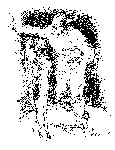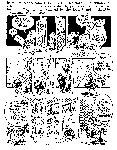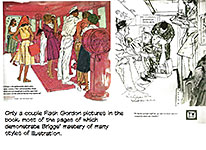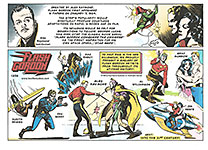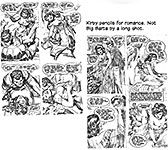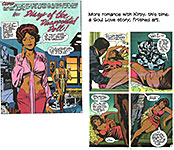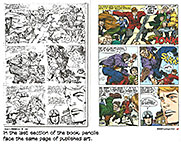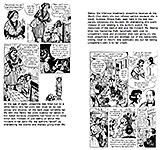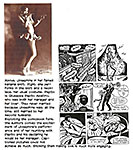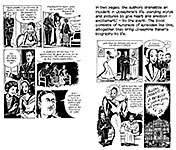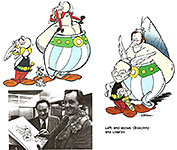 |
||||||||||||||||||
|
Opus 402 (April 13, 2020). The virus plagues comicbook biz with shutdowns, cancellations, and postponements, and Chris Ware offers tips for Isolation with his comic strip in The New Yorker. Also: the first Canadian to get the Herblock, Ted Rall loses (for now), labor editoonists retire, Josephine Baker superb graphic novel biog, Jack Kirby’s Dingbat Love: Unpublished ’70 Stories; Mineshaft Magazine. And the Trumpet is going to kill us all, plus last month’s editoons, and obits for Russ Cochran, Frank McLaughlin, and Albert Uderzo. In order to assist you in wading through all this plethora, we’re listing Opus 402's contents below so you can pick and choose which items you want to spend time on. Here’s what’s here, by department, in order, beginning with a reprise of the Queen’s uplifting speech (the longest entries are marked with an asterisk*)—:
TAKE HEART The Queen’s Speech
NOUS R US The Plague Shuts Down Comicbook Store Biz Diamond Suspends Distribution—Steve Geppi Coronavirus Shutterings, Postponements, Cancellations Salvation? A Scheme To Survive Newspapers No Better Off
* DeAdder First Canadian To Win Herblock Also: He’s Fired for Editoons Criticizing Trump
TED RALL LOSES. FOR NOW ...
END OF AN ERA * Labor Editoonists Retire
Harvesting Editorial Cartoons GOD WILL WATCH OVER HOBBY LOBBY Kubert School Goes Onlinse
ODDS & ADDENDA Zyglis Gets Nast Award New Byline for Mallard Fillmore History of Batman’s Robins Robin’s 80th Archie to Meet Flash Gordon Flash Auctioned for $480,000 Sing Happy Birthday To Wash Hands
FUNNYBOOK FAN FARE Marvel’s Empyre Sex on the Covers
ANOTHER CHRIS WARE Less to Chris Ware Than Meets the Eye Artist Isolation New Yorker Cover: “Bedtime”
* TRUMPERIES No Joke Anymore: What Others Are Saying
* EDITOONERY Democrat Race Coronavirus —and More
* NEWSPAPER COMICS PAGE VIGIL The Bump and Grind of Daily Stripping
BOOK MARQUEE Short Reviews Of—: Will Eisner’s Expressive Anatomy Austin Briggs: Consumate Illustrator Jack Kirby’s Dingbat Love: Unpublished ’70 Stories Genius of Ub Iwerks, Disney’s Ultimate Inventor * Mineshaft Magazine
GRAPHIC NOVELS * Josephine Baker Biography
ONWARD, THE SPREADING PUNDITRY Various Outbursts of Political Import
HE’S GOING TO KILL US ALL How Trump’s Self-Preservation Results In the Deaths of Millions
Counterpoint: Online Editoon Magazine
PASSIN’ THROUGH Russ Cochran * Albert Uderzo Allen Bellman (Next Time) Frank McLaughlin
QUOTE OF THE MONTH If Not of A Lifetime “Goddamn it, you’ve got to be kind.”—Kurt Vonnegut
Our Motto: It takes all kinds. Live and let live. Wear glasses if you need ’em. But it’s hard to live by this axiom in the Age of Tea Baggers, so we’ve added another motto: Seven days without comics makes one weak. (You can’t have too many mottos.)
And in the same spirit, here’s—: Chatter matters, so let’s keep talking about comics.
And our customary reminder: don’t forget to activate the “Bathroom Button” by clicking on the “print friendly version” so you can print off a copy of just this installment for reading later, at your leisure while enthroned. Without further adieu, then, here we go—:
We’re all in it together even if we’re six feet apart. Especially then.
Are you re-using toilet paper yet? That’s the next step, kimo sabe. It wouldn’t be a problem had the human species not changed its alimentary habit. In the very early days, people squatted to poop, and that eliminated the need for toilet paper, according to Carl Hiaasen in his book, Flush. Well, think about it. But nowadays, we need toilet paper. And we tend to panic when we can’t find any—which happens because people in the grip of the pandemic panic buy carload lots of it, leaving nothing for the rest of us. As The New Yorker reported (March 30), a newspaper in Australia performed a generous public service: it ran eight mostly blank pages for its readers (“Run out of loo paper?” the tabloid asked; “The NT News cares.”) “Loo” is slang for the lavatory, derived from French l’eau, meaning “water,” which, in turn, alludes to “water closet,” an early term for lavatory. If I wash my hands first, is it okay to touch my face?
TAKE HEART Here, in reprise, is Queen Elizabeth II's April 5 address to the United Kingdom in full—the kind of speech that many Americans have remarked we sorely miss in these troubled times from our so-called leader, who can do nothing but blow his own trumpet. And now, the Queen—: I am speaking to you at what I know is an increasingly challenging time. A time of disruption in the life of our country: a disruption that has brought grief to some, financial difficulties to many, and enormous changes to the daily lives of us all. I want to thank everyone on the NHS [National Health Service] front line, as well as care workers and those carrying out essential roles, who selflessly continue their day-to-day duties outside the home in support of us all. I am sure the nation will join me in assuring you that what you do is appreciated and every hour of your hard work brings us closer to a return to more normal times. I also want to thank those of you who are staying at home, thereby helping to protect the vulnerable and sparing many families the pain already felt by those who have lost loved ones. Together we are tackling this disease, and I want to reassure you that if we remain united and resolute, then we will overcome it. I hope in the years to come everyone will be able to take pride in how they responded to this challenge. And those who come after us will say the Britons of this generation were as strong as any. That the attributes of self-discipline, of quiet good-humored resolve and of fellow-feeling still characterize this country. The pride in who we are is not a part of our past, it defines our present and our future. The moments when the United Kingdom has come together to applaud its care and essential workers will be remembered as an expression of our national spirit; and its symbol will be the rainbows drawn by children. Across the Commonwealth and around the world, we have seen heart-warming stories of people coming together to help others, be it through delivering food parcels and medicines, checking on neighbors, or converting businesses to help the relief effort. And though self-isolating may at times be hard, many people of all faiths, and of none, are discovering that it presents an opportunity to slow down, pause and reflect, in prayer or meditation. It reminds me of the very first broadcast I made, in 1940, helped by my sister. We, as children, spoke from here at Windsor to children who had been evacuated from their homes and sent away for their own safety. Today, once again, many will feel a painful sense of separation from their loved ones. But now, as then, we know, deep down, that it is the right thing to do. While we have faced challenges before, this one is different. This time we join with all nations across the globe in a common endeavor, using the great advances of science and our instinctive compassion to heal. We will succeed— and that success will belong to every one of us. We should take comfort that while we may have more still to endure, better days will return: we will be with our friends again; we will be with our families again; we will meet again. But for now, I send my thanks and warmest good wishes to you all.
NOUS R US Some of All the News That Gives Us Fits
THE PLAGUE SHUTS DOWN COMICBOOK STORE BIZ The chain reaction, the cycle. Restaurant workers, waiters and waitresses, are at the low end on salaries, depending largely upon tips. Being laid off (or furloughed) is disastrous for them. But closing restaurants reaches even further into the economy. Farmers lose a market for lots of their produce when restaurants close. So farmers are threatened with financial failure. If that happens widespread, agriculture disappears. Then what, aristotle?
THE CHAIN REACTION IN THE COMICBOOK INDUSTRY IS SIMILAR. It begins with the government mandated shuttering of comicbook shops as nonessential businesses. Comicbook publishers, with a substantially reduced outlet for their product, are pulling back on their publication schedule. Or they stop publishing altogether. In reaction, the nation’s direct market distributor, Diamond Comic Distributors, suspended its operation and halted distribution of new product. Diamond is another of those nonessential businesses, and several of its distribution centers have been closed by local edict. Until comicbook shops re-open, the entire industry is threatened. And many will not re-open: the direct market has always been frail financially. And comicbook publishers, which have been living on the direct sales market (i.e., comicbook stores, some 2,000 nationwide) instead of newsstand sales, will likely cut back even more drastically. Just a week ago (no April Fool this), Diamond announced that it would not pay publishers that week because of cash flow problems caused by disruptions in the supply chain (i.e., closed comicbook shops haven’t revenue enough to pay their bills). If I were a comicbook cassandra, I’d say the comicbook industry is looking death in the face. Here’s what Steve Geppi at Diamond wrote about the decision to stop distributing until further notice. There are some caveats, as you’ll see—:
AS EVERYONE KNOWS, the world faces ever-increasing challenges related to the Covid-19 pandemic. Its effects on the comics & collectibles and tabletop gaming industries have been felt far and wide. We are hearing from thousands of retailers that they can no longer service their customers as they have in the past, many of them forced to close by government action or resort to in-person or curbside delivery. Even those still open are seeing reduced foot traffic in most cases, a situation that seems likely to worsen with time. Our publishing partners are also faced with numerous issues in their supply chain, working with creators, printers, and increasing uncertainty when it comes to the production and delivery of products for us to distribute. Our freight networks are feeling the strain and are already experiencing delays, while our distribution centers in New York, California, and Pennsylvania were all closed late last week. Our own home office in Maryland instituted a work from home policy, and experts say that we can expect further closures. Therefore, my only logical conclusion is to cease the distribution of new weekly product until there is greater clarity on the progress made toward stemming the spread of this disease. Product distributed by Diamond and slated for an on-sale date of April 1st or later will not be shipped to retailers until further notice. For the time being, however, we have been able to develop procedures with our teams at the distribution center in Olive Branch, Mississippi to safely continue fulfillment of direct ship reorders for the retailers who are able to receive new product and need it to service their customers. ... With these changes in our distribution strategy, we will work with our publishing partners to develop programs that will address product already in the pipeline and what will happen when we resume distribution. ... Besides the industry’s most immediate needs, we have been and will continue looking toward the future, when we see stores reopening, bringing staff back onboard, and getting customers in the door. We are looking at issues like debt accrued due to this crisis, what reduced ordering means for discount tiers, and the availability of credit to help stores through and after this difficult time. We don’t have all those answers today, but we understand the many issues you are facing and look forward to addressing them as partners who all have an interest in the long-term health of the industry we love so much. As I mentioned [earlier], this industry has been one of the greatest joys of my life, from my days as a collector to a retailer to today. I and my Leadership Team have made these decisions knowing full-well the effect they will have on all of you, as well as our publishing partners and our own team members around the world. At the end of the day, the safety and security of our teams and yours, along with the many customers we all serve, is paramount. I again thank you for your ongoing patience and support.
And There’s More Bad News DAILY CORONAVIRUS COMICS BIZ ROUND-UP Starting with a post by Milton Griepp on March 23, 2020 @ 3:16 am CT Dynamite Entertainment will reduce its planned releases for July to six issues and no merchandise, the company announced Friday, March 20. "This way, if things are still being pushed back, it’s less of a commitment of titles for fans and retailers," CEO Nick Barrucci said in a message to retailers. The issues planned for July are Vampirella No.13, The Boys No.4, Red Sonja No.18, Sacred Six No.3, Bettie Page No.2 and Green Hornet No.2. ... Last week, Dynamite announced that it would take returns on current releases beginning last week and for the next four weeks. Papercutz has pushed back its relaunch of Asterix, a major retooling of the property for U.S. audiences, to July 14, Bastille Day, the company announced. The relaunch, which includes new editions in new formats, was originally scheduled to kick off May 19. Half Price Books has closed all 120 stores for in-person browsing at least through March 31, "because we are committed to the health and well-being of our employees, our customers, and our communities across the country," the company announced. The company will offer curbside pick-up at most stores. And comic cons are collapsing, moving meeting dates from May and June to July. And hoping that’s enough. The American Library Association has postponed its annual convention for the first time in 75 years. Reed Exhibitions has postponed BookExpo, the biggest annual U.S. trade show in the book business to July, along with BookCon and UnBound from May to July 22-26. "Booksellers, librarians, authors, publishers, fans and everyone passionate about this industry are what make these events so special," Event Director Jennifer Martin said in a statement. "At every step and with every decision, we have you in mind, so it’s our responsibility to make sure that your health and safety come first at all times." Reed Exhibitions’ Reedpop division has already rescheduled geek culture shows Emerald City Comic Con and Supercon. At this writing, no word about the San Diego Comic-Con International, slated for July 23-26. But I have little hope that it will meet on its announced dates. The Denver Pop Culture Con, scheduled for July 4th weekend, has cancelled those dates and will instead meet over Thanksgiving. More bad news arrives daily, but I’ll stop with this: all fresh news is pretty much along the lines established above.
SALVATION? Bleeding Cool has suggested a way out of the looming disaster. Comic shops might be able to sell digital codes for comic books through their websites then redeem them for print comic books later, maintaining the weekly reader buzz without sacrificing the physical and collector mentality. They were told that the bureaucracy behind such a plan would be untenable. But it turns out that various people have been working on just this scheme for some time. “Publishers can already post preview pages for upcoming titles for the existing ComicHub customer tools. When customers register their account, they link with a physical print store. Which means stores don't need even their own website. Customers order comics, receive them digitally and then redeem them for the physical copy at their comic book store at later date. Adding a shopping cart means that publishers, creators and stores get paid. That means there and then, without having to wait. Even Diamond can get paid in advance for that physical distribution as and when printing and distribution returns. This is a major game-changer for a comic book industry, under shutdown.” Still sounds pie-in-the-sky to me, but I’m the original computer luddite. In any event, these things are changing daily, hourly. My e-pistle in-box is filled every day with new disaster reports and more salvation reports. By the time you read this, who knows? Not me.
NEWSPAPERS NO BETTER OFF Newspapers have been in serious trouble since the arrival of the Internet which cut into subscriptions and advertising. The pandemic has resulted in further loses in advertising revenue. D.D. Degg at dailycartoonist.com quotes Mike (Mike Lynch perhaps?), in italics—: The industry is already in rough shape, and we can argue how much of that came from the Internet itself and how much was from a colossally foolish lack of response to the Internet and how much of that colossal foolishness was due to stock-swapper stupidity masquerading as newspaper management. Now advertising has suddenly fallen off a cliff, in large part because— why advertise when your doors are closed? Again, the “why” is less critical than the “what” and the “what” is that wounded newspapers have lost a whole lot of revenue and nobody knows when it will come back, or even if there will ever be a restoration of what we knew as normalcy The Tampa Bay Times is suspending print publication except for Sunday and Wednesday because advertising revenue has plunged. “In just the last two weeks,” Times CEO said, “—cancellations have cost us more than $1 million, and there’s no sign of quick recovery on the horizon.” Many businesses are closed due to the pandemic and local edicts to shutter. If they’re not open, why advertise? The Times will furlough some staff while print days are suspended. And
free weeklies are crashing. The Chicago Reader is being distributed as a
PDF only. When the mandate for social distancing shut down so many of
Chicago’s bars, nightclubs, concert halls, and restaurants, the Reader lost
about And the chains are not spared. Gannett advised its staff that it will be instituting furloughs and other cost reductions in response to big advertising declines. Those who earn more than $38,000 annually will be scheduled to take an unpaid week off on a rotating basis. And here’s editoonist Ben Sargent to remind us what is being lost.(Alas, this is not a clear image: the light she’s turning off is labeled “newspapers”; and the Statue of Liberty in bed is labeled “democracy.”)
De ADDER FIRST CANADIAN TO WIN HERBLOCK Not only has editoonist Michael de Adder won the 2020 Herblock Prize but he will also receive an honorary degree from his alma mater Mount Allison University at the spring convocation in May. At an April ceremony at the Library of Congress, de Adder received the Herblock $15,000 prize and a Tiffany trophy. “It feels amazing,” said de Adder, “— how could it not? Even some of the second-place finishers are some epic cartoonists. I’ve admired some of these people’s work forever, so it’s kind of mindblowing. I don’t think I’ve really processed either the honorary doctorate or winning the Herblock yet,” he told Stephen Cooke at thechronicleherald.ca. Asked whether the awards were a sign that 2020 would be his year, the cartoonist laughs and replies, “I heard it was the Year of the Rat, wasn’t it? I guess that’s appropriate if you talk to Donald Trump supporters.” He
could be referring to any number of his cartoons featuring a spray-tanned,
hair-challenged commander-in-chief, said Cooke, “but the one that will come
immediately to mind is last July’s image of the president manoeuvering his golf
cart past the bodies of Salvadorans Oscar Alberto Martinez and his daughter
Angie, who died while trying to cross the Rio Grande into the United States. “The cartoon went viral online almost instantly,” Cooke continued, “— inspiring outrage and admiration in equal measure, while also ended his 17-year relationship with Brunswick News papers in the Moncton-born cartoonist’s home province. He was let go in 2019 because he too often criticized the Trumpet for his border policies.” De Adder is now signed on with Counterpoint, a newsletter that celebrates a diverse field of cartoonists from different political perspectives as well as the Toronto Star and the Halifax Chronicle Herald. He cites one of the biggest reasons for the success of his work as knowing you only have a few seconds to make an impact, and developing a style that gets his points across without resorting to clunky labels or over-exaggerated caricatures. “Like any artist, I’m wracked with self-doubt,” he says, “but despite that, I have confidence in my ability to produce at least something understandable.” De Adder has won numerous awards for his work including seven Atlantic Journalism Awards plus a Gold Innovation Award for news animation in 2008. He won the Association of Editorial Cartoonists’ 2002 Golden Spike Award for best editorial cartoon spiked by an editor and the Association of Canadian cartoonists 2014 Townsend Award. He has been nominated for four National Newspaper Awards and was shortlisted by the National Cartoonists Society for the Reuben Division Award in Editorial Cartoon category. He studied art at Mount Allison University where he received a Bachelor of Fine Arts in drawing and painting. He began his career working for The Coast, a Halifax-based alternative weekly, drawing a popular comic strip called Walterworld which lampooned the then-current mayor of Halifax, Walter Fitzgerald. This led to freelance jobs at the Chronicle-Herald and the Hill Times in Ottawa, Ontario. After freelancing for a few years, he landed his first full time cartooning job at the Halifax Daily News. After the Daily News folded in 2008, de Adder became the full-time freelance cartoonist at New Brunswick Publishing. He has over a million readers per day and is considered the most read cartoonist in Canada. He is a past president of the Association of Canadian Editorial Cartoonists and spent five years on the board of the Cartoonists Rights Network. This year’s Herblock judges were Dan Perkins, aka Tom Tomorrow, creator of the weekly political cartoon This Modern World and winner of the 2013 Herblock Prize; Michael Rhode, archivist and author, commentator on comics for the Washington City Paper and creator of the ComicsDC blog; and Eric Shansby, American cartoonist and children's book illustrator whose work appeared most prominently in the Washington Post. About de Adder’s work, the judges noted “There were many strong submissions in this moment of political crisis in America. The judges ultimately chose Michael de Adder for his elegant yet concise draftsmanship and his ability to distill complex issues into impactful visual statements. De Adder, who recently lost his job due to criticism of the American president, embodies Herblock’s standard of courageous independence, as defined in the award.” The Herblock finalist for 2020 is Matt Lubchansky who will receive a $5,000 after-tax cash prize. The judges said “Matt Lubchansky is an up-and-coming artist whose work exemplifies the cadence and structure of a new generation. Their work was distinguished by a wide diversity of subject matter and a cleverly askew sense of humor.”
TED RALL LOSES. FOR NOW ... Rall is suing the Los Angeles Times for defamation and wrongful termination. We reported in detail his situation in Opus 342a, and we thought he had a good case. But his crusade hit a brick wall when, a week or so ago, the California Supreme Court ruled against him. Here’s his report—:
LA Times’ Billionaire Owner Buys a Hospital. Next Day, CA Supreme Court Tosses My Case. Am I a victim of the Covid-19 pandemic? Legally, maybe. Reversing direction unexpectedly, the California Supreme Court has decided NOT to hear my defamation and wrongful termination lawsuit against the Los Angeles Times, billionaire publisher Austin Beutner, and parent company Tribune Publishing, which at the time of my firing was owned in large part by the Los Angeles Police Department pension fund. Adding to the confusion, the Court decertified the Court of Appeals ruling against me. This means that, while I will soon be ordered to pay close to $1 million to the LA Times for their legal bills defending themselves from lying about me in two articles, I can take comfort in the fact that Rall v. LA Times will not be used to screw over other journalists under California’s anti-SLAPP statute. My case cannot be used as a precedent. It’s sort of like Bush v. Gore. You are welcome, California journalists. You are safe. Why did the court make the decision they made? There’s no way to tell. They issued a pair of trite phrases: “Petition for review denied; CA opinion decertified.” After five years and thousands of pages of opinions and blood and sweat and tears, that’s all she wrote. It is possible that, as a friend of mine speculated this evening, the court didn’t want to sanction a disruptive decision against a major newspaper at a time when dozens of newspapers are going out of business every day. What is interesting is the timing. A few weeks ago, the California Supreme Court signaled to my attorneys that it planned to kick my case down the road for at least several months due to the Covid-19 epidemic and the closure of California courts. Then, yesterday, the current owner of the LA Times, biotech billionaire Dr. Pat Soon-Shiong, made headlines by announcing his intention to buy a closed Los Angeles hospital for the purpose of treating coronavirus patients. $135 million dollars buys a lot of good will at a time like this. The very next day, my case went away. Coincidence? Perhaps. Perhaps not. Who knows? My attorneys and I are exploring next steps. I will keep you posted. In the meantime, please stay safe and thank you so much for your support. I don't know if this is the end of the road or not. I can tell you that I will never stop fighting for our rights, whether it's in court or in the streets.
END OF AN ERA Labor Editoonists Say Farewell with a New Book “After 37 years of syndicating Huck/Konopacki Labor Cartoons to unions and newspapers, these Wisconsin-bred practitioners of pushback, parody, and in-your-face outrage against enemies of the working class sent out their last monthly package in February” reported Kathy Wilkes at labornotes.org For more than three decades, said Don McIntosh at nwlaborpress.org, cartoons from Huck/ Konopacki have appeared in the Northwest Labor Press. “So it came as a shock to learn in February that labor cartoonists Mike Konopacki and Gary Huck are closing down their cartoon syndicate.” On the heels of the news of their retirement, the duo announced Torn, the last collection of their editorial cartoons, which you can order here: http: // huckkonopackicartoons.com/ purchase/ buy-our-books/ At
the height of their popularity in the early 1990s, McIntosh continued, the pair
were sending out monthly packets of cartoons to 120 labor newspapers across the
United States and Canada, but that has dwindled in recent years as unions
shrank and merged and many labor papers ceased to publish. Huck, now retired, was for many years employed full time as a political cartoonist for the United Electrical Workers (UE) union. Konopacki got his start drawing cartoons for the University of Wisconsin student paper, and in the late 1970s started drawing labor cartoons between shifts as a bus driver. The two met at the 1979 convention of the Association of American Editorial Cartoonists and began operating their syndicated cartoon service in 1983. Wrapping up their cartoon syndicate means an end to their commitment to produce and distribute a dozen or more cartoons a month for labor union newspapers. But Konopacki says the two will still draw occasional cartoons and post them on their web site— HuckKonopackiCartoons.com — they don’t know what else to do, he says. At news of their retirement, kudos and bouquets were flung their way. Peter Gilmore, retired managing editor, United Electrical News: “Huck and Konopacki created the soundtrack of our lives: the laughter, weeping, shrieks and guffaws provoked by their deft blows against the bourgeoisie. I’m forever grateful they’re on our side.” Clay Bennett, Pulitzer Prize-winning cartoonist: “They have gallantly shoved their pen-weapons up the butts of bosses. Huck and Konopacki have truly earned their place in the anals of labor history!” [Read that again: Bennett has deliberately misspelled annals.—RCH] Clearly, Gary and Mike aren’t just your run-of-the-mill entrepreneurs, Wilkes said, picking up the narrative and continuing forthwith—: They carved out their corner of the labor movement with sharp insights and finely honed commitments to union principles, human rights and political activism. Their shared vision, talent for art, and working-class roots ensured that they didn’t just draw a good line, they walked it. Gary grew up union. His dad, a factory worker, was a labor leader in Racine, Wisconsin, where bustling factories have since been shuttered. Gary pinpoints the genesis of his career to an art project in the second grade: he had to draw a picture of his father’s work. In the 1970s, Gary illustrated pamphlets for striking Racine teachers and later became the cartoonist for the newspaper, Racine Labor. The mid-1980s brought him to his cartooning job for UE News, the newspaper of the United Electrical, Radio and Machine Workers of America. He recently retired. Mike grew up in Manitowoc, Wisconsin, another town afflicted by plant closures. His father managed the commercial art department for the now long-gone Mirro Corp. A University of Wisconsin grad, Mike became a teamster, drove a school bus part-time, and pursued a freelance career. He got his official start cartooning in the late ’70s for the Madison Press Connection, a newspaper by workers striking the Wisconsin State Journal and The Capital Times. He went on to work almost exclusively for the labor movement, including a law firm specializing in labor strategies, local and international unions, and Press Associates Union News Service. After meeting at the 1979 convention of editoonists, they pair launched Huck/Konopacki Labor Cartoons four years later. Each month they’d send subscribers a package of labor and political cartoons lampooning the rich and famous and championing the poor and obscure. Their cartoons became so much in demand that they published seven collections, in volumes spanning the Reagan/Bush era to Donald Trump. Wherever there was a strike, an organizing drive, a victory rally, or a spirited protest, H/K cartoons were inevitably purloined for all kinds of propaganda. Gary and Mike can still take pride in the fact that they are two of the most ripped-off cartoonists in the United States. Freelance projects also kept them busy. Gary’s gag cartoons, “Oddservations,” for the alternative press and Mike’s monthly tabloid, Wage Slave World News, supplemented the syndication along with workshops for budding and seasoned trade unionists and artful agitprop for union T-shirts, buttons, leaflets, posters, and picket signs. Wherever the movement was, whatever the movement needed, they were there. They still are! They’re not going anywhere anytime soon. Though their syndication has ended, Gary and Mike are available for workshops, strike projects, and special artwork.
HARVESTING EDITORIAL CARTOONS The Humor Times, a monthly tabloid printing page after page of editorial cartoons, has just celebrated its 29th anniversary. Subscriptions are $24.95 for 12 issues; $2 less if you subscribe online at subs.humortimes.com. I’m scarcely an objective bystander with this: the Humor Times publishes an excerpt from Rancid Raves once a month, and I get my subscription without cost. But I paid for my subscription for at least 10 years before the present cozy arrangement. Another monthly editoon tabloid is the Santa Cruz Comic News. It’s been going for more than 36 years; subs are $33/year at the website, thecomicnews.com I take ’em both and love ’em both. James Israel, who publishes/edits Humor Times, runs his own prose editorial in each issue; he’s decidedly liberal if not progressive (whatever distinction that implies). Here are some of his thoughts on Bernie Sanders—: Sanders has done the country a great favor by popularizing positions that were once unthinkable in the U.S. ... When polled on the individual issues, the public says it is overwhelmingly in favor of the positions Sanders espouses. ... People are ready for Medicare for All because they know it’s absurd that we are the only industrialized democracy left on earth without some form of it ... Likewise, people can see it’s insane to put students in deep debt to start out their professional lives. They see great examples across the ocean of countries that educate their youth through college for free (or for comparatively little). It’s obvious to most that education is an important investment in the country itself. ... People know intuitively that the massive wealth inequality we now have is extremely destructive to democratic principles and creates a class—the “billionaire class” as Sanders calls it—that wields far too much power for an unelected group of people.
GOD WILL WATCH OVER HOBBY LOBBY The chain of craft stores is bucking local edicts to close by staying open during the pandemic. In a letter to employees, CEO David Green explained that while the coronavirus pandemic is “certainly concerning,” God informed his wife, Barbara, last week that He will specifically protect Hobby Lobby and its employees and “groom us to be better than we could have ever thought possible.” Nice to know. Meanwhile, Hobby Lobby’s policy threatens the rest of us, everyone who enters the store but is not a divinely protected employee. Hobby Lobby’s religious beliefs in operating their business have been protected by the U.S. Supreme Court, which ruled a year or so ago that family businesses like Hobby Lobby did not have to provide employees with insurance coverage for services that would violate the Greens’ religious beliefs. At the time, the Greens said: “The Court’s decision is a victory, not just for our family business, but for all who seek to live out their faith. We are grateful to God and to those who have supported us on this difficult journey.” And now we see how Hobby Lobby’s religious beliefs threaten the rest of us. In living out their faith, the Greens endanger us all. Not so nice. Fortunately, in Denver at least, Hobby Lobby was forced to close its stores—probably elsewhere, too—demonstrating that there’s an end to this “living out their faith” stuff. You can’t do it if doing it endangers others. Nice.
KUBERT SCHOOL GOES ONLINE Press Release The famed Kubert School is proud to announce, for the first time in its history, that it will be offering an online studies program to the general public beginning Wednesday evening, April 15th. The courses being offered are Narrative Art taught by Tom Mandrake (The Spectre), Inking by Joe Prado (Superman), Script Writing for Comics taught by Amy Chu (Red Sonja), and Basic Drawing taught by Fernando Ruiz (Archie). Each class will meet once a week over the course of 6 weeks.
ODDS & ADDENDA Adam Zyglis of the Buffalo News won this year's Overseas Press Club prize, the award formerly known as Thomas Nast Award, for his international political cartoons. ... Loren Fishman got recognition for his Mallard Fillmore work when his name is added to the Sunday title panel on April 5, the first new Sunday Mallard since November 2019. ... George Gene Gustines at the New York Times on March 12 traced the history of all of Batman’s Robins—Dick Grayson (who lasted for forty years), Earth-Two Dick Grayson, Jason Todd, Carrie Kelley, Tim Drake, Stephanie Brown, Damian Wayne (the product of a Bruce Wayne - Talia al Ghul love affair), Duke Thomas. ... DC is claiming this is Robin’s 80th anniversary. He first appeared in Detective Comics No.38, cover-dated April 1940 (available in a just-published facsimile edition), and DC is showcasing 12 memorable/defining moments in his career at https://www. dccomics.com/blog/ 2020/03/19/boy-wonderful-twelve-moments-that-defined-dick-grayson Archie will meet Flash Gordon in a 48-page special issue in June, written by Jeff Parker and drawn by Dan Parent. In the book, the Riverdale gang discover a crashed alien spaceship that leads them to the planet Mongo and Ming the Merciless, with Flash Gordon in tow. Incidentally, the original art for the first Flash Gordon on Sunday, January 4, 1934, sold at auction last month for $480,000, a record for comic strip art. When officials at the Profiles in History auction house first saw the art, they couldn’t believe their eyes that such an artifact existed. The backstory is amazing. A client whose late husband was a life-long comic collector was in the process of appraising his collection. She sent the auction house a picture of the work, which was framed on her wall, and the rest is history. If you want to use a stop watch to make sure you wash your hands for 20 seconds, you can, of course, do so. But I’ve taken another piece of advice from an unknown source: I sing “Happy Birthday” twice, addressing it to Sheldon. (Sheldon is a two-syllable word and therefore takes a fraction of a second longer to sing.) Because I sing silently to myself, singing two “Happy Birthdays” doesn’t take quite 20 seconds, but if I say “a thousand years” in basso profundo at the end of each of the two verses, it works out perfectly. Imaginary basso profundo: I sing silently to myself remember.
Fascinating Footnit. Much of the news retailed in the foregoing segment is culled from articles indexed at https://www.facebook.com/comicsresearchbibliography/, and eventually compiled into the Comics Research Bibliography, by Michael Rhode, which covers comic books, comic strips, animation, caricature, cartoons, bandes dessinees and related topics. It also provides links to numerous other sites that delve deeply into cartooning topics. For even more comics news, consult these four other sites: Mark Evanier’s povonline.com, Alan Gardner’s DailyCartoonist.com, Tom Spurgeon’s comicsreporter.com, and Michael Cavna at voices.washingtonpost.com./comic-riffs . For delving into the history of our beloved medium, you can’t go wrong by visiting Allan Holtz’s strippersguide.blogspot.com, where Allan regularly posts rare findings from his forays into the vast reaches of newspaper microfilm files hither and yon.
FURTHER ADO Procrastination is the art of keeping up with yesterday.—Don Marquis If a clown farts, does it smell funny? (T-shirt Wisdom)
FUNNYBOOK FAN FARE Four-color Frolics WHEN THE DIAMOND PREVIEW arrives every month with its 550-plus page catalog of coming enterprises, I sometimes think of it as a “preview” of the industry, not just a glimpse of comicbooks on the horizon. In the case of the March issue, we have the Marvel portion that spends 16 pages on what seems a multi-title cross-over called Empyre. Sixteen pages at one title per page means that a dedicated fan would spend $63.84 to indulge his passion. All good fun, I’m sure, but who among us has that kind of money to follow the entire series from beginning to colorful end? Near here are a couple scans of the latest attractions.
The Spider-Man illo is just fun, but the Trashmaster cover on display does something to the guy’s thighs that I’ve never seen before. Take a look. A couple years ago, I chastized the one of the publishers, I think it was Marvel, for depicting a scantily clad female on virtually every cover that month. In this issue of Previews we have mostly somewhat more modest maidens, comparatively speaking.
But
when we get to Vampirella and Red Sonja and Dejah Thoris, the wraps come off,
and we have a smorgasbord of mammary on view. The picture of Finally, a couple covers of the old funnybook sort—fun, in other words.It took me a second or so to realize that Lonely Receiver (that must be she) has a body coming out of her right eye. Maybe that’s not intended as a fun thing, but it struck me that way. The Vampirella Red Sonja cover is just havin’ fun, pure and simple.
QUOTES & MOTS Shakespeare wrote of ‘desiring this man’s art and that man’s scope.’ I find this comforting. But who was he thinking of? Marlowe? Someone forgotten although evidently fucking incredible?— Writer Peter Schjeldahl in The New Yorker (December 23, 2019).
ANOTHER CHRIS WARE Usually, there’s less to Chris Ware than meets the eye. His characters are rendered in simple repetitive geometric shapes with no personality, and his line is sturdy and undeviating. To further simplify, nothing ever happens in a Chris Ware strip. There is no action: there is only slicing of life into tiny fragments. And the lives sliced are wholly uneventful. Or, rather, the events of these lives are entirely of the interior sort and therefore do not lend themselves to representation in a visual medium. So
it’s something of a relief to see his one-page comic strip in the March 30
issue of The New Yorker. The presence of a one-page comic strip in the
magazine is a symptom of the preferences of its young cartoon editor, EmmAllen,
who claims to like “long form” cartoons. In this strip for the first time that I can recall with Ware, something happens: Ware talks about the solitary life of a cartoonist, using himself as an example. (Yes, he really does have a bean-shaped head.) He offers rules—do’s and don’ts—for a satisfying life in isolation. And he footnotes it all with revealing insights into the lives of Charles M. Shulz (Peanuts) and R. Crumb (sexist cartoons and the book of Genesis), of artists and writers generally, and his own aversions to sports and heaven. For the first time on record, Ware is being satirical in a way that is obvious and, therefore, humorous. The satire is that a cartoonist’s life is exactly the sort of life recommended to slow the progress of the coronavirus—the kind of life that everyone doesn’t much like. But cartoonists—one of them anyhow—love it. A
week later, Ware is on the cover of the magazine. His covers are better than
his comic strips. What are we to make of this one? It’s a scene in a hospital during the Covid-19 crisis. The hallway is full of people, some of them being treated; others doing the treating. The further into the scene we go, the more evidence of a crowded hospital. But the center of the cover picture is another picture. A nurse (her sex indicated by curly hair, eyelash, and earring) is looking at her phone and seeing her husband and her two children, safe in bed. They are safe. No one else in this cover scene is. Ware has given us two worlds—one is safe and the other is in crisis. Those two worlds are ours these days. Ware says the cover reflects the double meaning of “bedtime”: emanating from the cool blue and green center of the image are the warm pink hues of a cellphone — as a mother on duty pauses to say a virtual good night to her children. “The cover was born not only from my daughter’s admonitions” about safety, Ware said, “but also from all of the admiration and anxiety I have for the heroic hospital staff who are faced with confronting the compounding unknown over these coming weeks and months.” “I’d imagine that there are few people who do not have at least someone in their family involved in medical care,” Ware said. “And even if they don’t, the doctors, nurses and first responders all have families of their own, about whom they’re all just as terrified and worried as we are.”
Feetnoot. WARE’S RIGHT about isolation: it’s a cartoonist’s working mode. Solitude. Alone at the drawingboard. I don’t do much actual cartooning anymore—not enough to require solitude all day long. But writing is as solitary a vocation as cartooning, and I write 3-4 hours a day. Sometimes longer since the plague. So the stay-home social distancing is no great inconvenience. It is, in fact, almost a way of life for me and has been for years. I’m almost 83, so I’m well within the vulnerable population. I have no underlying health issues with my lungs or other innards. I have neuropathy which manifests itself as pain in my right foot. But I doubt that foot pain creates an opportunity for Covid-19 to enter. But who knows? We have very little research on Covid-19. Very few answers. My wife and I have been isolated in our home for almost a month. We live on the northeast shoulder of Denver, at the western edge of the Great American Desert. It’s dry and barren in these parts, but we’re in the midst of a vast housing development in which residents try to grow trees and shrubs. Trees and shrubs in a desert. Whenever we leave home, we’re in that desert. We miss seeing friends and relatives. But we stay in touch by phone and e-mail. Our daughter and our grandson live about twenty minutes away. They’ve come over twice. We sit on our deck, chairs 8-10 feet apart, and converse as always— although we talk louder. So far, we’ve left the house only to go to the grocery store. The local grocery has an Internet mechanism that permits us to shop by computer. Then we drive over to the store a few hours later and pick up whatever we’ve ordered on the computer. Sometimes we don’t get everything we order because of shortages (toilet paper) or flaws in the supply line (yesterday’s ham, I suppose). But usually, it works fine. And we never have to come in close proximity to any other human being. And that, of course, is the sad part—that we must win by staying apart. Contrariwise, staying apart is what brings us together. Staying apart is a small price to pay compared to the price others have paid in the deaths of loved ones. That’s the terror that lurks beyond the front door, invisible and deadly. The terror and the surpassing grief.
MOTS & QUOTES If you want to know what God thinks of money, just look at the people he gave it to.—Dorothy Parker Money is better than poverty, if only for financial reasons.—Woody Allen I’ve got all the money I’ll ever need—if I die before four o’clock this afternoon.—Henny Youngman
TRUMPERIES The Idiotic Antics of Our Self-Aggrandizing Buffoon in Chief
No Joke Anymore Editoons encourage us to laugh at the Trumpet. And much as we enjoy doing it, the time has passed for that. He now—and for several weeks—has constituted the worst threat to American life we have yet encountered. By way of illustrating this alarming fact, here are excerpts from various periodicals that are now going beyond catching him in lies to condemning his actions wholeheartedly.
THE FIRST OFFICIAL ACT of the Trump Administration was the Inauguration—and, within hours, a lie delivered from the White House press room about how this had been “the largest audience to ever witness an Inauguration, period, both in person and around the globe.” That episode seems so long ago, and many thousands of lies ago. But as the world now faces a pandemic, it has never been more essential to recall that norm-setting performance and to admit what has been demonstrated on a daily basis about the public official who carries ultimate responsibility for the public safety of American citizens: Donald Trump is incapable of truth, heedless of science, and hostage to the demands of his insatiable ego. —David Remnick, The New Yorker
THERE IS A THROUGH-LINE: Trump himself, constantly conflating the national interest with his personal interest. As the coronavirus spread and the president initially ignored, downplayed, and lied about it—even dismissing coverage of the risks as a media-inflamed “hoax”—the costs of the Senate’s impeachment decision have been cast in sharp relief. It will be a long time before we can reckon with the full damage done by an Administration whose incompetence, disinformation, and sheer bungling in the early stages of the crisis have been at once predictable and breathtaking. Trump has spent years devaluing and diminishing facts, experts, institutions, and science—the very things upon which we must rely in a crisis—and his default setting during the coronavirus outbreak has been to deny, delay, deflect, and diminish. His speech on Wednesday night was a disappointment but not a surprise. He told us what we already knew: America is in big trouble.— Susan B. Glasser at The New Yorker
THOUSANDS OF AMERICANS are about to die because for three long months, as the virus raged through Asia and then Europe, Trump “brazenly denied reality” since he saw it as a threat to the booming stock market and his re-election. Insisting that the Covid-19 is no worse than the common flu, he actively resisted widespread public testing because, in his words, “I like the numbers where they are.” ... The crisis has exposed our overwhelmed narcissist-in-chief as “fundamentally unfit—intellectually, morally, temperamentally, and psychologically—for office.” —Peter Wehner in TheAtlantic.com
WHEN PAYCHECKS disappear and the hospitals and morgues overflow, Trump’s failures will be “so blatant that even his own supporters will notice.” For critical weeks, Trump was a passive and willfully ignorant bystander to an unfolding disaster, insisting that the virus would just “go away.” As president, he owns responsibility for the slow U.S. response to the pandemic. —David Frum in TheAtlantic.com
FOR THREE LONG MONTHS that we can’t get back, the president “failed to rise to the challenge of leadership.”—NationalReview.com
OUR “BIZARRELY CAVALIER” president is refusing to use his powers to address a problem he’s allowed to “fester for months.” ... He says he’s holding out for a “worst-case scenario.” How bad do things have to get?—The Boston Globe
LATELY CLAIMING that the cure may be worse than the disease, Trump started advocating “to have the country up and raring to go” by Easter. It’s clear that Trump “is willing to sacrifice lives to save the economy and his chances for re-election. ... This heartless logic is now spreading in the GOP and on Fox News. Who’s advocating “death panels” now?—Matt Lewis in TheDailyBeast.com
TRUMP AND HIS SYCOPHANTS in the GOP have decided that 1 million or more deaths is a small price to pay for a resumption of the roaring economy on which Trump had pinned his hopes of re-election.—Dana Milbank in the Washington Post
TRUMP’S DESIRE TO GET US ALL BACK TO WORK puts the president—who has repeatedly downplayed the threat posed by the virus—starkly at odds with infectious-disease specialists, public health officials and most other elected officials, who say months of restrictions may be needed prevent wide devastation.—The Week
AND AT HIS NEWS CONFERENCES, Trump avoids facts and instead picks on reporters for “bad reporting” if they criticize him. Ditto governors, who he has lambasted for not “treating us well.” They are instructed to be more appreciative of Trump’s efforts, such as they are.—Jennifer senior in the New York Times.
BUT TRUMP FINALLY relinquished his desire to let people loose in the world by Easter when he received a visit at Mar-a-Lago from Tucker Carlson, who broke ranks with his Fox News colleagues and urged serious action.—David Remnick, The New Yorker
EARLY LAST WEEK (March 23 ff), the Trump era—which defined itself by a lurid celebration of “alternative fracts,” a contempt for science, and an assault on global institutions and the “administrative state”—came to an end. Regrettably, Donald Trump remains in office, but, at least for the moment, he appears to have ceded the argument: he cannot bend the harshest realities of the world to his fantasies. The aggressive and deadly coronavirus is unimpressed and unimpeded by the bluster of a con. Yet the prolonged process of Trump’s humbling, the time it took him to recognize the power of the global pandemic that has emptied our streets, has put untold numbers of Americans at risk. ... Trump cannot be forgiven for his preening and his belatedness.—David Remnick, The New Yorker
From the Web—: Reporters are skipping President Donald Trump's daily coronavirus news briefings, and tv networks are increasingly choosing not to broadcast them live, because they believe they don't have enough news value to risk breaking social-distancing rules. In recent days there have been scores of empty seats in the White House press-briefing room, where Trump has delivered updates on the U.S. battle against the novel coronavirus alongside public-health officials. But instead of delivering key information and sober assessments of the situation to the American public, Trump has frequently resorted to tactics more familiar from his raucous campaign rallies: boasting of his accomplishments, floating misinformation, attacking the press, and taunting Democrats — with Governor Andrew Cuomo of New York a favored target. According to the Washington Post, reporters are now "keeping their distance because they are concerned about the health risks at a time when many consider the president's evening news conferences to have become increasingly less newsworthy." In other words, reporters no longer want to listen to Trump bullshit. His press conferences consist of two attributes: comments on the corona virus, which either falsify information or are misleading; and tirades of vituperative contumely heaped up on Democrats, the news media, and others who have failed to fawn over him enough—in short, his pep rally shit.—RCH
Of course, Trump wasn’t alone asleep at the switch as the plague loomed. Several (if not numerous) government agencies were complicit in ignoring the slowly accumulating evidence. Many of those agencies, however, were seriously understaffed due to the Trumpet’s budget cuts. And Trump did nothing to shore up the collapsed system.
AS THE FIRST ALARMS sounded in early January that an outbreak of a novel coronavirus in China might ignite a global pandemic, the Trump administration did virtually nothing, thereby squandering nearly two months that could have been used to bolster the federal stockpile of critically needed medical supplies and equipment. A review of federal purchasing contracts by the Associated Press shows federal agencies largely waited until midi-March to begin placing bulk orders of N95 respirator masks, mechanical ventilators and other equipment needed by frontline health care workers.—The Associated Press
AS I WAS SAYING—: Return with us now to the ostensible subject of this department—Trumperies, editorial cartoons that represent the Prez in his usual self (you know, the egotistic insecure blowhard that we have all come to know and despise). We
begin, as usual, with magazine covers. To
kick off an array of editoons, we have a series of insightful Trumpet portraits
by Tom Bachtell across the top of the page. At the lower right, Chris Britt shows us the results of a test performed upon the Trumpet, with the results all negative. And at the lower left, Nick Anderson deploys a visual image of the Prez at the center of his “inner circle,” which looks an awful lot like a bunch of gangsters surrounding their employer. Fazenda
is again at the center of the next visual aid. At the lower right, Pat Bagley shows us the Trumpet surrounded by another breed of sycophant, Evangelicals, who are all naked, telling the press to eschew stories about emperor’s new clothes. Like that fabled emperor, they can’t see the truth about themselves—that they are supporting a morally lax person. Bagley continues at the lower left with a visual metaphor of the Trumpet as a magician, issuing pardons by waving a wand over his top hat, out of which has emerged a veritable swarm of unsavory rodents. Not cute bunny rabbits. By some charitable stretch of the imagination, Trumpery editoons show us Trump as he imagines himself. In our next section, Editoonery, we’ll see Trump as he appears to sane observers.
CLIPS & QUIPS Go now in peace—never be afraid. Go now in faith, steadfast, strong and true. Go now in love, and show you believe. Reach out to others so all the world can see. Go now in peace, in faith, and in love. —RCH modification of Don Besig
EDITOONERY The Mock in Democracy THE
PAST MONTH OR SO has been marked by two events of a political nature: first,
Joe Biden suddenly, after miserable performances in the Iowa caucuses and the
New Hampshire primary, emerged as the leader in the Democrat race for the
presidential nomination; second is the invasion of coronavirus and the
Trumpet’s failure to adequately respond to it. And the covers of The Week and The New Yorker that we’ve posted hereabouts focus on those two
happenings. The Week is my favorite weekly news magazine because not only does it seem to cover events comprehensively albeit briefly (at just enough length to encourage me to read all its accounts of what happened last week), but it always includes a page of editorial cartoons (sometimes two pages) and the cover of the magazine is always a full-color political cartoon—in the case at hand, focusing on the surprising outcomes of the first ten or so Democrat primaries. (Bernie Sanders deliciously portrayed trying to hold on to the Dem jackass is a hoot.) On the cover of The New Yorker, Trump is wearing a mask, which, alas, doesn’t cover his mouth or stop it. And, as usual, he has it all wrong. Although the coronavirus had begun to seep into the country by early February, the Trumpet’s disgraceful reaction took a little longer to get into the public eye, and when it did, it blew Bernie and Biden completely out of the water. We’ll get to that shortly, but, taking matters as they occurred in editoons, we’ll begin with the Democrats. Joel
Pett starts us off with a comic strip, the format permitting him to
assemble a succession of Bernie Sanders images proclaiming his various
programs, which the Democrat donkey accepts one-by-one until we get to
Democratic Socialist, which is what Bernie is, and then the jackass chokes,
making a noise that sounds almost like “check.” But not quite. Nice touch. And below Sack, Steve Breen arranges the elements of his picture to show that Democrats do not at all support Bernie—although they are, indeed, united. And at the lower left, Breen is back with another look at Bernie’s fate, offering a view of “revolution” that is markedly different than Bernie’s. In
the next array, R.J. Matson presents a vivid pictorial that dramatizes
Biden’s And with that, we end our survey of the Democrat race for the nomination and turn to the coronavirus plague that threatens the nation.
DAVID
HORSEY’s visual
metaphor is a doctor’s office that presents a MAGA-cap wearing stalwart who,
like the Trumpet and the rest of his unthinking followers, denies medical
science and finds support in the utterances of other non-scientists, Rush
Limbaugh and Sean Hannity. And then resorts to a typical Trumpet
maneuver—attacking the doctor by supposing him to be a Democrat. Next around the clock, Walt Handelsman reports the “good news” at the graveside of a person who died of Covid-19 because the Trumpet’s response to the menace of the coronavirus was too slow. Then Clay Bennett shows us all the venues that are closed in order to slow the progress of the disease—all except Trump’s mouth, which continues to broadcast erroneous information every time it opens. Finally, Nick Anderson offers a somewhat bitter picture of life on the beaches during Spring Break as irresponsible college students persist in cavorting in the sun despite the admonition to avoid crowds and to maintain a 6-foot distance from others. In
the next exhibit, John Darkow’s image is that of a Trump daily briefing
and pep rally with the Trumpet standing on his head, which suggests that his
press conferences are more entertainment than information. And/or that the
Trumpet’s understanding of the real world is upside down. The other figure is
Dr. Anthony Fauci—one of the sober voices at these affairs—who is muttering to
himself, “Why do I always feel dumber after one of these?” No kidding. Trump has instructed Vice Prez Mike Pence, who is running the coronavirus task force, not to call governors who are not appreciative. Trump: “I say, ‘Mike, don’t call the governor of Washington; you’re wasting your time with him,’” Trump said. “‘Don’t call the woman in Michigan. It doesn’t make any difference what happens.’ You know what I say—‘If they don’t treat you right, I don’t call.’” Trump prevented the Democrat governor of Colorado from securing 500 ventilators from a private company—instead, taking the ventilators for the federal government. Later, Trump sent 100 ventilators to Colorado “at the request of Senator Gardner” (Gardner is a Republicon and a vociferous butt-licking supporter of Trump). Corruption and moral bankruptcy, thy name is Trump. He’s playing politics with peoples’ lives, doling out life-saving medical equipment as favors to loyalists. Yet just the other day, a friend of ours who is a Trumpist, was singing his praises to the skies. To return to our display, Chip Bok offers two panels in which Nancy Pelosi makes an incriminating accusation of Trump, and he responds by explaining what he was doing instead of preparing to face the virus. Trump actually said this, which proves what we’ve always thought: he can’t do two things at once, chew gum and be Prexy of the U.S. Dave Granlund’s visual metaphor reminds us that the Trumpet wanted the whole pandemic to be over by Easter. Then he allowed himself to be talked out of it. So far. With
the next array, Clay Bennett’s metaphor has a grocery shopper looking at
empty shelves, and the shelves are labeled with Trump shortcomings: the shelf
tagged “Sound judgement” is empty. Next around the clock, Dave Whamond continues the toilet paper imagery: the Trumpet takes a second away from his golf game to fling a role of toilet paper at a Covid-19 victim in his sick bed. You’ll remember that throwing rolls of paper at victims is the standard Trumpet manner of alleviating disasters. problems. Then Gary Varvel revives the Wall image, this time so Mexico can pay for it in order to protect its citizens from the plague. Clever of Trump to have arranged for this. The
plague is still the over-arching subject in our next visual aid.
TICS & TROPES: AN INTERLUDE Strange things to get your mind off politics—: The dot over the letter ‘ i ’ is called a tittle. A duck’s quack doesn’t echo. No one knows why. The name Wendy was made up for the book Peter Pan. There was never a recorded Wendy before that book. Charlie Chaplin once won third prize in a Charlie Chaplin look-alike contests. Bats will always turn left when leaving a cave.
TO
RESUME, THEN, we continue an examination of the images editoonists have used to
ponder the pandemic. Next, we move directly from Bolling’s conclusion to Bill Bramhall, whose image presents exactly what we were all thinking in the last panel of the preceding cartoon. Run, run, run. At the lower right, Kevin Siers has produced the very best image of a shiny shoe we’ve seen in months. The image gives vivid visual reality to an old saying, demonstrating that the shoe of the Presidency is too big for Trump to fill. And then Daryl Cagle superbly reproduces one of those giant waves from Japanese art to show how futile is the Trumpet’s desire to fill church pews at Easter. He’ll simply be overwhelmed by the coronavirus. The speech balloons, too tiny to read here, say: “We have it totally under control ... We gotta go back to work ... I would love to see packed churches on Easter.” Everything he says demonstrates his complete ignorance. In
the next display, Steve Breen pairs a couple images—Disneyland and the
White House—to argue that there’s more fantasy in the Trumpet’s claim that his
virus response has been “perfect” than there is in the Magic Kingdom. Next, Chris Britt’s overweight tiny-handed Trump is shown overpowering—and
silencing—scientists in his daily briefing on the pandemic. Across the bottom, an installment of the comic strip Prickly City. Bylined by editoonist Scott Stantis (drawn by Eric Allie), the strip makes political statements, as in this instance, with the Trump character (a skunk!) telling the coronavirus to stop making him look bad. I suspect that being a skunk does more to make him look bad than whatever the virus is doing. But it’s like Trump to blame others for his gaffs, including his appearance. The image of the U.S. as Humpty Dumpty in Tom Toles’ metaphor strenuously suggests that the Trumpet’s effort to get the country to open by Easter will have the traditional Humpty Dumpty result with the country too broken for all the king’s men to put together again.
WITH
OUR NEXT VISUAL AID, we leave the pandemic as a topic for a while and focus on
the operations of the Grandstanding Obstructionist Pachyderm. But at the lower right, Joel Pett shows how little such considerations matter to the GOP elephant, which, with its eye on History, the Pachyderm believes it will write. Then Nick Anderson arranges for an image that condemns the GOPachyderm as a socialist because of the socialistic bail-out money the Republicon-controlled Senate agreed to give to all Americans—just like a good socialist government would do. Moving
on to a smorgasbord of miscellany, we have Scott Stantis with a gloomy
picture of an exhausted, beat-up looking Uncle Sam creeping “out of
Afghanistan—finally.” The Taliban is a religious extremist movement; it controlled Afghanistan prior to 9/11, after which we invaded the country and unhorsed the Taliban. But they haven’t lost religion: they’re just waiting for us to leave, after which, they’ll move in again. As Theunis Bates, managing editor of The Week, said in the March 13 issue, “By most measures, America’s nearly 20-year-old war there is a failure. ... The Taliban have surged back and now control 50% of the country. Our efforts to create a thriving democracy have also amounted to nothing. The government in Kabul is riddled with corruption and is hugely unpopular.” The whole exit enterprise sounds remarkably like Richard Nixon’s “peace with honor” in Vietnam—where neither peace nor honor prevailed when we left. Instead, we managed an “escape” that looked like some other kind of achievement. It’s the same in Afghanistan. Next around the clock, Barry Blitt takes several panels to show us medals Rush Limbaugh has won, the cartoonist’s reaction to Trump giving the radio blabbermouth the highest honor at the President’s disposal. Judging from the medals, Rush is a racist, sexist, homophobic, imbecile. Then Dave Granlund offers an image of Chris Matthews being hit by a hardball—MSNBC’s decision to “retire’ him. Matthews is one of my favorite tv personalities to dislike, but he’s being mistreated by MSNBC. On the Tuesday, March 2, broadcast of “Hardball,” host Matthews said that would be his last hosting of the show: he’s retiring in the wake of several controversies, some of which revived long-standing criticisms of his behavior on-air. “Most recently, he likened Bernie Sanders campaign to the Nazis. When Sanders took an early lead in the Nevada caucuses last month, Matthews likened the moment to Nazi Germany invading France during World War II. Aides to Sanders, who is Jewish, expressed shock at the analogy.” I don’t think Matthews intended a ethnic slur. I think he was alluding to the swiftness of Sanders’ conquest. The remark is typical of the sort of “hardball” utterance Matthews is accustomed to making, usually engaging his mouth before his brain. I’ve often wondered how Matthews lasted for 20 years on “Hardball.” He’s always talking, usually over the voices of his guests. How does he know what to say if he’s never listening? Matthews also allegedly made sexist comments to Laura Bassett. Bassett recalled Matthews saying things like "Why haven't I fallen in love with you yet?" and other "gross and inappropriate" comments. Geez: I would think Matthews’ asking why he wasn’t in love with her is a compliment, not a sexist remark. But then, I’m somewhat in Matthews’ generation wherein such remarks were widely accepted. Matthews acknowledged the altered situation: In his resignation speech, Matthews noted that workplaces today implement “better standards than we grew up with — fair standards. A lot of it has to do with how we talk to each other.” He continued: "Compliments on a woman's appearance that some men, including me, might have once incorrectly thought were okay, were never okay. Not then and certainly not today," Matthews said. "And for making such comments in the past, I'm sorry." Nicely put. When he thinks before he speaks, Matthews is worth listening to. Matthews has been expected to retire after the 2020 Election, but he’s been in talks with management for months. The controversies over some of his remarks accelerated the talks. He indicated that the decision to step down was not entirely his. “Matthews was told by management to step down, said a person with knowledge of the situation, who characterized it as a firing that was masked as a retirement announcement.” So now, television’s most visible loud mouth (other than Trump) is gone. And that’s too bad. We grow complacent in the absence of a voice that’s sometimes deliberately offensive. Someone who plays hardball. About Daryl Cagle’s cartoon at the lower left, I think I may have posted this one before. If so, so what? It’s a great and accurate image of why our “national conversation about race” is forever failing.
OUR
NEXT COLLECTION of miscellany begins with Steve Breen’s image of the
American bald eagle on the Boy Scout badge, here manifesting chagrin over the
scandal now enveloping the organization, whose leaders have been sexually
molesting the boys entrusted to their care for generations. I’m letting Randy Glasbergen’s cartoon stand for a comment on the stock market and the economy in the age of pandemic even though the cartoon isn’t an editoon and was drawn years ago—before Glasbergen’s death in 2015. His cartoons are still around on the Web, and I love ’em—particularly the way he draws noses. Glasbergen is the champion nose-drawer in the known universe. And his line is crisp and his blacks well spotted. He’s a treat for the eyes. Steve Sack’s visual metaphor isn’t about the Trumpet’s announced plan to ignore and punish governors who aren’t sufficiently deferential to him—although that almost works here. Rather, Sack is showing how Trump’s behavior contradicts his policies. He doesn’t want anyone to waste disaster relief funds but Sack notes that he’s spent $115 million of taxpayer money on his own golfing pleasures. The amount includes transportation, plus salaries and housing and living expenses for an entourage of Secret Service agents. Pat Bagley’s dog at the lower left is wearing a MAGA cap so we know the mutt is a Trumpist. And in Bagley’s image, wherein the dog is doing what dog’s do—drinking out of the toilet—the toilet is actually Fox News, which follows the Republicon line all day long. Apt all around. Notice the realistic touch: the dog is wagging its tail as it imbibes. We’re
back to the coronavirus pandemic in our next visual aid. These things keep
cropping up every day, and these are the latest manifestations. Clay Bennett shows us the Trumpet being more proud of his tv ratings in his daily press
conferences than he is concerned about whatever is happening with the virus. Steve Kelley makes a joke at the upper right, and Kelley is just the person to make a joke: he moonlights sometimes as a stand-up comic in nightclubs, bars, and other lowly joints. The joke depends upon there being a shortage of hand sanitizers. Next is Lalo Alcaraz, working outside his comic strip La Cucaracha and producing here a verbal-visual comparison of the fact-based no-nonsense press conferences of New York’s governor Andrew Cuomo and the press conferences of the Trumpet, who spends much of his time whining about the Democrats and Bronco Bama, his predecessor, who, Trump continues to allege without a shred of evidence, left everything in a mess when he departed the White House. Then
here’s Dave Whamond with an image of the Trumpet watching Queen
Elizabeth’s upbeat response to the pandemic in England. Trump, predictably, reacts
in the terms he himself values—ratings and popular praise (from his legions Finally, to wind up with a couple recent acquisitions, “late breaking opinion” you might say, here’s Jen Sorensen with a series of pictures about “plague insurance” that you might need. The format is not that of a comic strip because the pictures are not sequential. Each is a snapshot —or a stand-alone poster of advertisement. Each level of coverage is a comment on some failed aspect of our health care program. And then at the bottom, in Tim Campbell’s image, the picture is all: it shows us where Dr. Fauci no doubt wants a bar of soap to be inserted. If not up the Trumpet’s ass, then in his mouth to stop his whining and whimpering. (I’m not sure the scan clearly shows the square thing in Trump’s mouth is labeled “soap”; so I’m doing it here, between parentheses.)
PERSIFLAGE & FURBELOWS It was Jamie Ducharme who observed, in a recent issue of Time —referring to a report from the World Economic Forum, that “if people all over the planet made one change—switching from beef to other sources of protein—global greenhouse-gas emissions would fall by 25% and diet-related deaths would drop by 5% in wealthy countries. Red-meat production is hard on the environment because raising cattle requires large plots of land and emits lots of greenhouse gases into the atmosphere.” And cows burping also emit greenhouse gases.
READ & RELISH The ancient Persians made big decisions by discussing them twice: once while drunk and again while sober. “Proof that we don’t understand death is that we put a pillow in the coffin with dead people.”—Jerry Seinfeld
NEWSPAPER COMICS PAGE VIGIL The Bump and Grind of Daily Stripping HAPPILY,
cartoonists keep finding ways to introduce potty humor into their strips,
thereby proving how much more liberal we have become since the good ol’ days
just 20 years ago when such things were not only severely frowned upon but
forbidden altogether. We start with Wiley Miller’s Non Sequitur comparison
of male and female alimentary practices in the woods. Next down the line-up we have Jerry Scott and Jim Borgman with Zits. The day before this episode, Jeremy, our high school hero, realized as he sat ready to take an exam that he needed to visit the Boy’s Room. He was understandably desperate because the teacher announced that no one could leave the room once the exam began. But Jeremy begged and pleaded, and, as we see here, the teacher relented and let him, er, go. After holding it for as long as he did, when he went, he erupted, and we are the witnesses. A beautifully executed event, but we’d never have seen any of it a couple decades ago. In Baby Blues, Rick Kirkman and Jerry Scott explore yet another of the verboten aspects of the human existence. Wanda and big-nose hubby Darryl are in bed, and events transpire that force Darryl to admit that he’s been farting too much. The word “fart” has actually appeared recently in a newspaper comic strip (I think it was in Stephan Pastis’s Pearls before Swine), so flatulence is, apparently, no longer a taboo topic either in name or function. On that topic, we are free at last. In Tom Batiuk’s Crankshaft, we have something altogether else. A woman gives birth in a movie theater—and cranky old Crankshaft assists in the delivery over the next couple days. Now that —childbirth— is wholly unprecedented in a family newspaper’s funnies. Finally, here’s Chad Carpenter with Tundra. The moths are exposing the bee-keeper’s butt crack. The bees will soon attack it. Why—what’s its attraction?—who knows. But butt-crack comedy isn’t often seen even in the liberated comics of today.
IN
OUR NEXT EXPEDITION, we examine the ways that comic strip art works by looking
at some strips that self-consciously exploit their very nature for a joke. In Macanudo, Liniers ponders about the spaces between the panels. In Pearls, Stephan Pastis plumbs another of the capacities of comic strips. I don’t know what he thinks a “ninny” is, but by the end of the strip, he’s multiplied the images of his characters in the same panel implying, it seems (at first blush), that those panels demonstrate the nature of a “ninny,” what it is. Or they are. Not so. The last panels that depict the same characters more than once in a panel are doubtless examples of the identity theft they are talking about in the first panel. But I missed that on the first pass; Mike Jenkins helped me out with an insight I failed to have. Next in the Walker’s Beetle Bailey, we go some place else. Therein, we simply have Beetle saying something to his girlfriend that is wonderfully romantic. And true, of course—always true. And then in Charles Schulz’s Classic Peanuts, Snoopy in his World War I pilot’s garb discovers that it is, indeed, a long way to Tipperary. A comic strip’s capacity to time events and actions—and here, thereby, to prolong an activity—creates the mystery about what Snoopy is doing that his concluding remark explains. It might be possible to create the same situation in another medium, but not as easily.
SINCE JEFF KEANE has gone to such elaborate lengths to celebrate a landmark
anniversary of Family Circus, the cartoon his father Bil created, it
seems only right and proper that we post the event here. By the way, Jeff is conducting the second most conspicuous legacy strip being continued by the offspring of its creator. Beetle Bailey is being produced these days by Mort Walker’s sons, Brian, Greg and Neal. Neal pencils and Greg inks (as he did for his father). All three participate in gag-writing sessions. Mort Walker did the first couple years of Beetle solo. After that, he was usually assisted by others. But he always penciled every strip. Both Family Circus and Beetle Bailey carry their originators’ signatures even though both creators have passed on; their names endure, as is appropriate for creators of such long-running comic strips. A few odd bits of information about Beetle: his name is actually Carl James, Beetle being a nickname; he is a member of "Kilo Company," 3rd Battalion of the 9th Infantry Regiment (United States), 13th Division (fictional). Beetle is the brother of Lois in Hi and Lois (a strip concocted by Mort Walker and drawn by his friend Dik Browne until he died; now continued by others). The grandmother came from Dublin, Ireland. Down the page, in Funky Winkerbean, Tom Batiuk has turned the strip on its side—probably to avoid having to draw three panels of talking heads. Well, I’m almost kidding. That happens often enough—two speakers carrying on a conversation for the entire strip. But in this instance, there are an awful lot of words; the easiest way to include them all was to eliminate most of the drawings. Another extraordinarily verbose strip is Sally Forth, drawn by Jim Keefe and written excessively by Francesco Marciuliano. Sometimes—as here—the words fill speech balloons to such an extent that the characters are nearly crowded out of the panel. I keep pondering such strips to see if the verbiage could be made into a gag at the halfway point. In this strip, the speech in the second panel is almost a concluding comedic note; it could have stopped there. Then the text of the last panel could be spread across three panels in the next day’s strip, wringing two strips out of one. Marciuliano could cut his workload in half.
ALTHOUGH
DRASTIC ACTION is probably not necessary, excessive speech balloons can be eliminated.
Churchy in Walt Kelly’s Pogo in June of 1961 has been
driven to distraction by speech balloons and takes decisive action. Blechman
continues his crusade across the bottom of the next visual aid. And Churchy
does the same in a return engagement in a Sunday Pogo from December
1962. I discovered these Pogo specimens whilst annotating the next in Fantagraphics’ Complete Pogo series, Volume 7, which embraces 1961 and 1962. My assignment is to explain various references in the strip to political events and literary expressions or fleeting societal preoccupations. Volume 7 will include another appearance in the strip of a pig representing Russia’s Nikita Khrushchev, who is joined by a goat who looks exactly like Cuba’s Fidel Castro. Don’t miss it if you can.
WE
BEGIN OUR NEXT OUTING with a couple installments of Brooke McEldowney’s 9
Chickweed Lane wherein Edda and Amos become the parents of twins. In the
top strip, McEldowney comes as close as possible to actually depicting the
birth of the babies. (He’s done daring stuff like this before—most notably,
Amos and Edda in the grip of connubial passion, for which McEldowney drew
entwined hands. Excellent.) Next, we have Over the Hedge by Michael Fry, drawn by T [no period] Lewis, starring RJ the raccoon who loves Twinkies, Verne the sensitive turtle, and Hammy, the squirrelly squirrel, who manages to get things to fall out of the sky—a cow, an electric flying convertible. And sometimes, as in the second strip, the woodland creatures have political insights to share. And then Jim Davis gives us the eponymous Garfield in three guises. In the first, we see the feline as he usually appears. In the second panel, his wide open mouth destroys an otherwise recognizable face, and in the third, the cat’s donut-stuffed cheeks seem to wrap around from behind and partially obscure his face. And that’s too bad. Only with a well-known character can a cartoonist get away with such distortions.
BROOKE
McELDOWNEY returns in the next visual aid, this time with one of his Sunday
strips that plays with the format. In Francesco Marciuliano and Jim Keefe’s Sally Forth we approach one of the ageless verboten subjects—writing your name in snow by peeing it. That’s not expressly mentioned here, of course, but what else is Ted talking about? Then finally, the strip I don’t get. Tundra by Chad Carpenter I usually grasp enough to understand the joke. This time, I’m lost. Any help out there?
PITHY PRONOUNCEMENTS You cannot hum while holding your nose. Unless you’re a professional dairy farmer who milks cows daily, it’s unlikely that you’d know that it takes, on average, 350 squirts to get a gallon of milk. The word “sophomore” is derived from the Greek words “sophos” which means “wise” and “moros” which means “fool.” “Run to the rescue with love, and peace will follow.” —River Phoenix, at the age of 17, quoted by his brother Joaquin as he accepted an Oscar for Best Actor for his role in “Joker” The best ships are wooden ships, sailing ships, and friendships.
BOOK MARQUEE Short Reviews and Proclamations of Coming Attractions This department works like a visit to the bookstore. When you browse in a bookstore, you don’t critique books. You don’t even read books: you pick up one, riffle its pages, and stop here and there to look at whatever has momentarily attracted your eye. You may read the first page or glance through the table of contents. And that’s about what you’ll see here, beginning with—:
Will Eisner: Expressive Anatomy for Comics and Narrative By Will Eisner with Peter Poplaski 180 8x10-inch pages, b/w; 2008 Norton paperback, $24.95 THE COPYRIGHT DATE on the book at hand is 2008, but I suspect it has been revised and re-issued more recently than that because Norton sent me this volume for review, and it would scarcely have done that with a book that’s twelve years old. This volume is the third in the trilogy of Eisner’s instructional books from Norton: Comics and Sequential Art and Graphic Storytelling and Visual Narrative are the other two. I have neither, but I do have Eisner’s 1995 Graphic Storytelling from his Poorhouse Press; and it would seem to tackle in one volume what the other two Norton titles do in two volumes. There is no question, absolutely none, that Will Eisner was a past-master at the art of telling stories in the medium he called Sequential Art—i.e., comics. But I’m not convinced by Expressive Anatomy that he is as accomplished in teaching his skills as he is in performing them. The book is full of Eisner art—some pencil sketches, some pictures of characters doing things, and some pages the panels of which are expressive in relating a scrap of story. Helpful as it may be to study these pictorial evidences, if there were accompanying text that described what we should see, to learn from, in the samples before us, the book would be more valuable as instruction. The example near here on the page at the left would be considerably enhanced if Eisner had examined each panel to say what it does to create surprise.
For example, the first 5 panels set the stage: they create the peaceful scene that is disrupted by the woman’s sudden command to the man to “get out.” And how does the anatomy of the woman serve that purpose? The book’s title, after all, is Expressive Anatomy. By the same token, some discussion of the body language displayed in the pencil picture at the right in our visual aid would improve the instructional value of the picture. The woman’s posture suggests that she is proud and self-possessed despite being dwarfed by the towering figure of the man next to her. Eisner’s caption says only that “through body language the major social, political and economic situations of a romantic confrontation” are depicted. True. But he could have said much more, directing attention to specific parts of the postures—the angle of the head, f’instance. In contrast, I’m posting a couple pages from Eisner’s earlier book, the 1995 volume, in which the pictures’ role in storytelling seems to me better explained.
But even without more specific verbal instruction, we have Eisner’s pictures. A whole book of them, divided into helpful categories. As always, the pictures are telling in and of themselves. These are the works of a master, as I said. And we can learn from inspecting them closely, supplying our own understandings instead of looking for Eisner’s. And even if you don’t get the book for its instructional value, Eisner’s pictures are there for you to simply enjoy.
Austin Briggs: The Consummate Illustrator By David Apatoff with Foreword by Austin Briggs, Jr. 160 9x12-inch pages, color; 2018 Auad hardcover, $34.95 THE CONSUMMATE part of this book’s title is amply demonstrated with a parade of Briggs’ work from the mid-1920s until he retired in Paris where he died in 1973. He began doing work for the pulps and advertising, then illustrations for airlines, then TV Guide, followed by books and magazines (Collier’s, Saturday Evening Post and Readers Digest). He was one of the founding faculty for the Famous Artists School and was recognized as one of America’s leading illustrators. He also drew Flash Gordon although when and for how long is a matter of some mild dispute. At the most, he was assisting Flash’s creator Alex Raymond from the very start of the Sunday strip on January 7, 1934, helping with the creation of the characters and then helping Raymond meet deadlines on his other strips, Jungle Jim and Secret Agent X-9, then on the daily Flash from its start in 1940 until 1944, when he took over the Sunday entirely and kept at it until 1948. That’s what Briggs’ son claims. At the least, Briggs helped occasionally on the Sunday strip through the 1930s; then, starting in 1940, did the new daily version of Flash until leaving that in 1944 to do the Sundays, which he left in 1948. That’s what the Raymond contingent claims. The chief bone of contention is how much Briggs was involved assisting Raymond in the 1930s. The Briggses claim a larger role than the Raymonds. Revealing, perhaps, is an anecdote Briggs Jr. tells. He was visiting his father in Paris one day when a delivery man from a wine merchant arrived, sweating and grumbling about carrying two cases of Burgundy up five flights of stairs. “When the man realized that the person who answered the door was the Flash Gordon artist he’d seen on a recent television interview, he almost dropped his precious cargo. Two hours later, and well into the second bottle of vintage Nuits St. Georges, my father and the delivery man were still talking. After the awed fan finally left, my father turned to his wife and me. ‘You know,’ he said with a happy smile, ‘I may someday be best remembered as the man who drew Flash Gordon.’” Whatever his other claims to fame as a “leading illustrator,” Briggs is undoubtedly right about his reputation with Flash Gordon. And those who produced this volume agree—as best signaled by their including the anecdote I’ve just quoted. But by far the bulk of this book’s pages are devoted to reproducing samples of Briggs’ illustration work in media other than the funnies pages of newspapers. Almost no Flash Gordon. Herewith, a short sample of the rest—to which I’ve appended a commemorative Flash strip honoring the artists who’ve worked on the strip. (Briggs is one of seven.)
Jack Kirby’s Dingbat Love Unpublished ’70s Stories by the King of Comics By Jack Kirby and Editor John Morrow; Introduction by Mark Evanier 176 8.5x11-inch pages, b/w and color; 2019 TwoMorrows hardcover, $43.95 EXCELLENT. SUPERB. This is the kind of book about a favorite cartoonist that you hope to find. That’s analysis enough of this volume. The rest is just description. When Kirby left Marvel and went to DC in the 1970s, he concocted many more new series than the Fourth World’s New Gods. But almost none of that effort has seen print—until now. Morrow convinced DC to let him publish all that marvelous missing stuff. And here it is. Here are the romance tales—True Life Divorce, The Maid, The Twin, The Model, The Other Woman, and The Cheater. And if you think Kirby’s glamorous women all look like Big Barta, these stories will persuade you otherwise. Kirby also did stories about romance among minorities in Soul Love— Go-Go Girl, Diary of a Disappointed Doll, Dedicated Nurse, The Teacher. One issue of Dingbats of Danger Street was published in the 1970s; but there are two more about this gang of street kids, and they’re published in this volume. When these were first concocted, apparently DC wasn’t enthusiastic enough about them (and all the other stories in this treasure-trove of a book) to publish. That’s why they’ve languished until Morrow needled DC into letting them go into print. Two of the Soul Love stories are published here in color, finished art, but a couple of the romance tales are just Kirby’s pencils—glorious to see how his pencil “thinks” its way through a story. And for several of the Dingbats stories, Morrow has published both pencils and finished art in color, the pencil facing the color page so we can see how the former evolved into the latter. Which is to say, not at all: Kirby’s pencils are so detailed and complete that neither Mike Royer nor D. Bruce Berry needed to make refinements as they inked. A truly stunning exhibition. Kirby’s art is accompanied by text. Morrow introduces each section with an essay that puts the Kirby stories in context. Jerry Boyd analyzes Soul Love, and Evanier shows up with a second Introduction. He and another Kirby “assistant,” Steve Sherman, supply work-a-day background on Kirby. And throughout, lots of photos and incidental art. This is the good stuff, kimo sabe. And now, nearby—samples of some pages.
ANOTHER INTERLUDE: PEEVES & PRATFALLS Willie Nelson told his daughter Paula an old joke about how he wants to go out: “When I die, I wanna go like my granddad did,” he said, “—passed out in his sleep. Not like the other screaming passengers in the car.”
Now back to work—: Walt Disney’s Ultimate Inventor: The Genius of Ub Iwerks By Don Iwerks 224 9.5x13-inch pages, b/w and color; 2019 Disney Editions hardcover, $60 MOST STUDENTS OF THE DISNEY LEGEND know that Iwerks was Walt’s partner in a couple animation studio attempts in Kansas City before Disney went to Hollywood in 1923; then Iwerks joined Disney the next year. This book fleshes out that outline a bit and contributes a couple tidbits. Iwerks left Disney in 1930 after an artistic disagreement; he returned a decade later and stayed the rest of his life, creating scores of special machines for visual effects, developing technologies and processes that contributed immeasurably to the success of the Disney product. Iwerks began as an animator. His skill amazed his colleagues in the 1920s, among them, Friz Freleng, who said: “At the [early] time, just making a character move was an accomplishment. He could make characters walk and move; he could move a house in perspective. I thought he was a genius when it come to the mechanics of animation.” Iwerks was not only accomplished; he was remarkably fast. “We thought of Bill Nolan as the fastest animator that ever lived,” said Grim Natwick. “Although Ub Iwerks denied that. He said ‘I think I broke Bill’s record: seven hundred drawings a day.’” He animated the first Mickey Mouse cartoon, “Plane Crazy,” completely by himself in less than two weeks. Iwerks helped develop the first Disney animation character, Oswald the Lucky Rabbit, and almost single-handedly animated “Steamboat Willie” and “The Skeleton Dance” before he left to start his own studio. But upon his return, he did no animation to speak of: his focus was on the machinery of animation and how to improve it. Among the tidbits that Iwerks’ son and biographer added— dispelling the rumor that Disney held a grudge against Iwerks (he didn’t; they were the best of friends); and asserting that Irwerks drew the first character designs for Mickey Mouse and was the original animator of the character. That’s not such a stunning fact: Mickey Mouse is just Oswald the Rabbit with round Mouse ears instead of flapping Rabbit ears. But there’s not much about Irwerks’ life in the book. (And the Freleng and Natwick quotes above come from Leonard Maltin’s Of Mice and Magic: A History of American Animated Cartoons [1980] not the Ultimate Inventor.) Rather, the book is mostly about his technological achievements. The page size suggests that the book will include lots of artwork. Nope: almost none—except for technical diagrams and photographs of machinery. And there’s not much drama or interest in a giant 9x13-inch photograph of Irwerks looking at a strip of film. Some of the stories are interesting even if their technology isn’t particularly gripping. For “That Darn Cat,” Iwerks developed a way to photograph a cat looking directly into the camera. He made a 18x24-inch box and put a 50/50 mirror inside (so it would reflect and yet was slightly transparent), a light bulb, a panel of clear plexiglas, and a couple of other accouterments. At the right moment, a live bird would be dropped into the box and the light bulb turned on, prompting the bird to move and make noise. The cat would see the reflection of the bird in the 50/50 mirror directly in front of the camera lens and stare at it. Presto. But if you’re not into gadgets and how to make them, this isn’t the book for you.
MINESHAFT is a 48 5.5x8.5-inch page magazine plus cover, which is often in a color, one maybe two. The interior is black-and-white. If you Google “Mineshaft,” you get this description: “Mineshaft is an independent international art magazine launched in 1999 by Everett Rand and Gioia Palmieri in Guilford, Vermont. Initially focusing on poetry and literature, the magazine began to publish comics after Robert Crumb became a contributor in 2000.” Since then, Mineshaft has published a number of other underground cartoonists. At the Mineshaft website, Gioia says: “Both Everett and I related to many of the old underground comics artists views of the world, their cynicism and way out open mindedness. Everett began to contact some of these artists and we were surprised at the generous response to contributing. The pages of Mineshaft began to contain work by Robert Armstrong, B.N. Duncan, Mary Fleener, Bill Griffith, Frank Stack, Aline Kominsky Crumb, Jay Lynch, and Kim and Simon Deitch.” If you read at the website more about Mineshaft and how it started and how it is produced, you get the distinct feeling that Gioia and Everett come from a different place. It was a place I lived in for a few years in college and shortly thereafter. People who lived there were sometimes called “hippies.” When I lived there, we were called “beatniks.” For the sake of the flavor, here’s Gioia on the beginnings of Mineshaft: “I asked Everett where he first had the idea for starting a magazine. He told me the idea came to him when he was staying at River Huts, a place run by an excellent Thai chef and her husband who was from Hawaii. Everett had a small thatched roof bungalow that overlooked the Mekong River. I was traveling in India at the time. This was the fall of 1997, and in 1998 to begin the new year, Everett and I met up in Bangkok and traveled south to Penang, Malaysia. “Everett decided to return to the west coast of the U.S. and pick up our old two-door Subaru that we had left with his cousins in Oregon. That same year in the summer he and I drove the car back to the east coast where we decided to live in Vermont. Through some friends that we met while working at the Common Ground Co-op Restaurant in Brattleboro we ended up renting the ‘Cook Shack,’ a 15-foot by 15-foot well-insulated cabin with a big woodstove, no electricity or running water, that was the oldest remaining building of a commune that existed on the property in the 1960’s. “It was in Vermont that Everett said to me that he would like to start a magazine. I asked him what the name should be and he said that he had liked ‘Mineshaft.’ This was the name translated into English of our favorite bar in La Paz, Bolivia where we had lived in the early ’90s.” You can read more in this enlightened vein at the Mineshaft website. Robert Crumb got involved in the magazine in about 2000. He still sends stuff that helps fill out Mineshaft’s pages. In a letter to Everett dated January 1, 2014, Crumb said: "Recently I've spent time going back and reading old issues of Mineshaft. Man, it holds up well over time, very high quality content, mercifully free of the usual commercial crap or pretentious arty-farty nonsense that pervades 99.9 percent of all print media. Mineshaft is anti-propaganda, anti-public relations. It is a modest little package speaking honest truths in words and pictures, thanks to you and Gioia's sharp editorial judgement." I’ve bought several of the recent issues of the magazine, and it’s a little disappointing sometimes. If Mineshaft had once been a simmering backwater for stray underground cartoonists’ marginal work and a few jaundiced cartoons and essays, those days have faded. That’s not to say, however, that you’d be wasting your ten bucks for an issue. I
have No.38, the most recent issie, in front of me, and there are four Crumb
drawings in it. There are also some antique photographs of women in short
skirts and a couple comic strips by people whose names I don’t recognize. But
one I do: a hilarious two-pager by Art Spiegelman. I’ve posted it near
here. Other
old timer names include Justin Green (who reviews a collection of
cartoons about dogs by Clare Briggs, H.T. Webster, J.R. Williams, Ed Dodd,
Frank Beck, and Stanley Link (I’ve sent for it via And the letters section keeps the old flame a-burning. Worth your time. Order at the Mineshaft website. The back cover of No.38 reproduces a full-page advertisement for “Fun-making Jokes and Tricks” that I’ve scanned and posted nearby. It’s too small to read as printed by Mineshaft, but if you print this off and enlarge it, you can read the hysterical descriptions of whoopee cushions and other mindless “jokes.”
IRKS & CROTCHETS To those feeling sad and desperate, I want to say—grab an oar.—Amanda Johnson
POME Hope is the thing with feathers That perches in the soul And sings the tune without the words And never stops—at all —Emily Dickinson
“The tune without the words”—that one.
LONG FORM PAGINATED CARTOON STRIPS Called Graphic Novels for the Sake of Status
Josephine Baker Written by Jose-Louis Bocquet and drawn by Catel Muller 570 6x9-inch pages, b/w; in English, 2017 SelfMadeHero paperback, $22.95 OR, PERHAPS MORE ACCURATELY— an-inch-and-a-half thick, weighing two-and-a-half pounds. A doorstopper of a book. It is also a model of a comicbook biography. These days, many biographies that assume the guise of graphic novel do so merely to hitch the writer’s hobby horse—the subject of the biography— to a popular “new” genre in hopes of finding a publisher eager to make sales in bookstores. But so many of these efforts make almost no use of the resources of the form: instead of blending pictures and words to tell their stories, the narratives of these books are carried by captions, and the pictures merely illustrate the captions. (So why have both?) In Josephine Baker, Bocquet and Muller successfully exploit the medium to tell the story of this African American entertainer who became a sensation in Paris in the 1920s by dancing almost nude and who then joined the French resistance during World War II and, after the war, deployed her fame to advocate for civil rights and racial justice, and, to prove a point, adopted and raised 12 children from different cultural and racial backgrounds. The book is successful as biography and as graphic novel form because it presents Baker’s life as a series of incidents and episodes, dramatizing the highlights and key moments of her life and career in picture and words. Each of the episodes is a story: they have a beginning, middle, and end. And the characters depicted talk and act—like comicbook characters everywhere. But they’re not just talking heads. Many other biographies in the genre fail, as I said, because they are only illustrated prose narratives. In properly using the form, Bocquet and Muller add drama and energetic life to the story of Josephine Baker. Baker was born in St. Louis in 1906 and died in Paris in 1975. An African American, she gained fame in the 1920s as an exotic dancer in Paris: headlining revues at the Folies Bergere, she danced nearly naked, saith St. Wikipedia, famously wearing only a short skirt of fake bananas and a beaded necklace. Baker was celebrated by artists and intellectuals of the era, who variously dubbed her the Black Venus, the Black Pearl, the Bronze Venus and the Creole Goddess. She renounced her U.S. citizenship and became a French national after her marriage to French industrialist Jean Lion in 1937. It was her third marriage, and until her fourth, none lasted longer than a year or so. Baker aided the French Resistance during World War II; after the war, she was awarded Croix de guerre by the French military, and was named a Chevalier of the Légion d'honneur by General Charles de Gaulle. In WWII, when the Germans invaded France, Baker left Paris and went to the Château des Milandes, her castle in the south of France. There, she housed people who were eager to help the Free French effort led by de Gaulle and supplied them with visas. As an entertainer, Baker had an excuse for moving around Europe, visiting neutral nations such as Portugal, as well as some in South America. She carried information for transmission to England—about airfields, harbors, and German troop concentrations in the West of France. She made occasional visits to the U.S. but refused to perform for segregated audiences and is noted for her contributions to the civil rights movement. In 1968 she was offered unofficial leadership in the movement in the United States by Coretta Scott King, following Martin Luther King Jr.'s assassination. After thinking it over, Baker declined the offer out of concern for the welfare of her children. During Baker's work with the civil rights movement, she began adopting children and forming a family (two girls and ten boys) that she often referred to as "The Rainbow Tribe." Baker wanted to prove that "children of different ethnicities and religions could still be brothers." In 1949, a reinvented Baker returned in triumph to the Folies Bergere. Bolstered by recognition of her wartime heroics, Baker the performer assumed a new gravitas, unafraid to take on serious music or subject matter. The engagement was a rousing success and reestablished Baker as one of Paris' preeminent entertainers. In 1951 Baker was invited back to the United States for a nightclub engagement in Miami. After winning a public battle to desegregate the club's audience, Baker followed up her sold-out run at the club with a national tour. Baker worked with the NAACP. Her reputation as a crusader grew to such an extent that the NAACP had Sunday, May 20, 1951 declared "Josephine Baker Day". She was presented with life membership with the NAACP by Nobel Peace Prize winner Dr. Ralph Bunche. Among her more famous utterances is what she said at the March on Washington, August 28, 1963. Martin Luther King’s “dream speech” is the better remembered, but Baker’s is notable for its blunt assertion of the cause of civil rights: “I have walked into the palaces of kings and queens and into the houses of presidents. And much more. But I could not walk into a hotel in America and get a cup of coffee, and that made me mad. And when I get mad, you know that I open my big mouth. And then look out, 'cause when Josephine opens her mouth, they hear it all over the world ...” Nearby, I’ve posted pages from the book that exemplify Bocquet and Muller’s manner of storytelling.
The verbal-visual narrative of Baker’s life ends with her funeral on pages 459-460. Then follows a 16-page “timeline” that tells the story of Baker’s life in straight chronological prose. That is followed by an 83-page section of one-page mini-biographies of the people in Baker’s story—her husbands and various celebrities, Eubie Blake, Ernest Hemingway, Georges Simenon, Colette, Le Corbusier, Charles de Gaulle, Grace Kelly and many others—and a bibliography. Anyone who aspires to produce a biography in graphic novel form is hereby urged to read this Josephine Baker as a guide to how such books should be done.
BEEFS & BOFFOS Life—: Life is not so bad if you have plenty of luck, a good physique and not too much imagination.—Christopher Isherwood Life is a near death experience.—George Carlin God knows life sucks. It’s right there in the Bible. The Book of Job is all about Job asking God to take away pain and misery. And God says, “I can’t take away pain and misery because then no one would talk to me.”—Bill Maher I intend to live forever. So far, so good.—Steven Wright
ONWARD, THE SPREADING PUNDITRY The Thing of It Is ... Fintan O’Toole on the Senate trial and the once and future Trump (New York Review of Books, February 27, 2020)—: “Then I have an Article II where I have the right to do whatever I want as President” (quoting the Trumpet). ... The first article of faith in the Church of Trump is that Trump is genetically superior, and this superiority manifests itself in his intuitions. ... The gut cannot be questioned: the job of everyone else in government is to accept what the leader does first and find the reasons later. ... The president cannot be removed from office for abusing his power in order to achieve a private end because his private ends are almost impossible to determine and thus are off-limits. ... Trump is always right, and the job of everyone else in government is to “provide the underlying analytics that confirm his intuition.” ... Republican senators are now quite openly behaving as courtiers. It is impertinent for courtiers even to go through the motions of putting the monarch on trial. They cannot be seen to consider evidence because that would imply that there is some objective reality against which Trump’s motives could be measured. They cannot even pretend to deliberate because that would imply that deliberation can hold its own against the imperative of Trump’s will. They cannot question what the president has done because that would violate the principle that his reasons are unquestionable. What is lost for them and for Trump in this process is any possible claim that the president has been vindicated by a genuine trial of the evidence against him. What is gained is the assurance that, if Trump wins a second term, he can indeed do whatever he wants.
THE TRUMP ADMINISTRATION is breaking the law. It bars asylum seekers from entering the U.S. to make their claim for asylum. U.S. law says they are entitled to enter the country and, having put foot on U.S. soil, to make their claim. Then they must await the decision by courts or judges about the validity of their claim for asylum. Nothing illegal about this. But Trump forces them to line up for months and await their turn at an official port of entry but on the Mexican side of the border. That’s illegal. Several cases on this question are making their way through the courts. The Supreme Court has ruled that until those cases run their course (and wind up at the Supreme Court), asylum seekers must await decisions on their cases on the Mexican side of the border as the Trumpet has decreed. According to the Associated Press, Human Rights First, an advocacy group that opposes the Trump policy, said it found more than 1,000 public reports of kidnappings, torture, rape and assaults of asylum seekers returned to Mexico. Meanwhile, the squalid overcrowded detention facilities have experienced outbreaks of Covid-19. More than 50,000 immigrants awaiting deportation hearings are being jammed into holding pens and cells so tightly they can’t sit or lie down. Detainees clean themselves with wet wipes and eat food so rancid it causes diarrhea. It’s only a matter of time before infections spread through these populations, and then—will the sick be treated in already overcrowded hospitals or left to suffer and perhaps die?
**** ANOTHER POME By the Shore —Steve Sufian
Cozy to walk barefoot on warm sand, Enjoy birds overhead: Perhaps we will find the levity within That will soar us up to glide upon a sky thread. Traditions tell of human flyers, And of witnesses to their flights, Witnesses to pure folks Rising in the Light that blends the day and night. Rising in the Light.
****
HE’S GOING TO KILL US ALL From the Washington Spectator Trump’s winter of indifference will cost American lives, but it wasn’t the main precipitating factor in America’s vulnerability to the Covid-19 virus. The roots of this tragedy trace back to the early months of his presidency, long before anyone had heard of Wuhan, when the newly-elected president sharply reduced the budgets of the nation’s infectious disease prevention system, and in particular the emergency health preparedness infrastructure put in place by the Obama administration to fight the Ebola outbreak. On his second full day in office, Trump introduced a 90-day hiring freeze, which left nearly 700 positions at the Centers for Disease Control unfilled. According to researchers and health officials interviewed by the Washington Post, the freeze adversely affected programs that supported local and state public health emergency readiness, infectious disease control and chronic disease prevention. Given the CDC’s crucial role in detecting and stopping infectious disease outbreaks, the public health community sounded the alarm. ... several of the vacancies were senior positions in the Office of Public Health Preparedness and Response, which according to the Post regulated some of the world's most dangerous bacteria and viruses and managed the nation's stockpile of emergency medical countermeasures. In January of 2018 the Wall Street Journal reported that the CDC was scaling back its global health security agenda by 80 percent because of Trump-mandated budget cuts. The top White House official in charge of fighting pandemics left the Trump administration abruptly in May 2018, and the global health security team he oversaw was subsequently disbanded under then National Security Advisor John Bolton ... as a consolidation to improve efficiency. ... With an administration that prioritized the concerns of industry over the role of science in government decisions, nearly 1,600 federal scientists left the government in Trump’s first two years in office. And at the end of his third year, 39 out of 79 scientific leadership positions remained vacant. In a 2018 survey compiled by the Union of Concerned Scientists, half of the respondents at the CDC agreed that “political interests hindered the ability of their [agency] to make science-based decisions.” One respondent at the CDC observed that “proposed funding cuts limits our [agency’s] capacity for responding to infectious disease overseas and domestically.” Trump has systematically sought to defund the agencies that protect national and global health. ... Across his four proposed budgets, Trump has attempted to cut nearly $154 million from the programs of the National Center for Immunization and Respiratory Diseases. ... Given the nationwide shortages of Covid-19 tests, questions abound around why the Trump administration chose not to use a functioning test from the World Health Organization. The administration could have removed regulations that prevented private hospitals and labs from quickly developing their own tests, but didn’t. This inaction meant that the United States fell behind South Korea, Singapore and China in fighting the virus. When asked last week about the government’s lack of preparedness for the Covid-19 outbreak, Trump responded, “Nobody knew there'd be a pandemic or an epidemic of this proportion. Nobody's ever seen anything like this before.” [And then, later, seeking to affirm his status as a stable genius, Trump said he knew the coronavirus was a pandemic before anyone declared it.] ... Twice before, according to the Times article, the federal government had issued dire warnings about official lack of preparedness and the country’s vulnerability to infectious pandemics. “In 2016, the Obama administration produced a comprehensive report on the lessons learned by the government from battling Ebola. In January 2017, outgoing Obama administration officials ran an extensive exercise on responding to a pandemic for incoming senior officials of the Trump administration.” All of these authoritative exercises identified the same challenges Trump is now belatedly scrambling to confront, armed with an underfunded and ill-prepared bureaucracy, hamstrung by years of his own indifference and mismanagement on the part of his administration. When asked about his role in the system-wide collapse, the 45th President of the United States resorted for once to the truth, and without irony: No, I don’t take responsibility at all. [And yet he’s almost directly, personally, responsible for thousands of deaths in the United States.—RCH]
**** From Counterpoint, a biweekly online selection of editorial cartoons—: As Congress cranks up the printing presses to bury the nation under a blizzard of money the government can’t afford to spend, Counterpoint’s lobbying team is joining the feral packs of special interest hogs wallowing around Washington’s $2 trillion public trough. We can’t keep the world’s greatest country in a complete lockdown on laughter. Our cartoons weren’t built to be shut down. Our nation’s editorial cartoonists desperately need $80 billion to maintain the infrastructure of ridicule essential for the survival of America’s satire industry. Give us the money now— in non-sequentially numbered, unmarked bills— and we’ll have everybody laughing again by Easter. And unlike a certain former presidential candidate, we’ll keep everybody on our payroll through November even if we blow a billion bucks and decide to give up. Show us the money. We’ll keeping showing you Counterpoint.
Counterpoint is free. And it’s deliberately duo-partisan: it takes care to present all political points of view in every issue. To subscribe, go to counterpoint.com
*****
WE’RE ALL BROTHERS, AND WE’RE ONLY PASSIN’ THROUGH Sometimes happy, sometimes blue, But I’m so glad I ran into you--- Tell the people that you saw me, passin’ through
Russ Cochran, 1937 - 2020 Cochran, who died February 23 at the age of 82, is likely the only person on the planet who one could say straddled the worlds of both university physics and classic comics archiving. By profession, he was a professor and chairman of the physics department at Drake University in Des Moines, Iowa; by avocation, he was an archivist of nearly every EC Comic ever published. He was also an art dealer with an impeccable reputation, a music historian, a good friend of both EC Publisher Bill Gaines and the Frank Frazetta family, and the proud owner of a chimp named Sammy. It was Cochran’s love of EC Comics that inspired him to become an influential publisher and art dealer as he recalled in a long interview with EC historian Grant Geissman in Tales of Terror, (an encyclopedic collection of all things EC, co-edited with long-time EC fan Fred Von Bernewitz). Cochran had actually stopped reading comic books, until he was inspired by a copy of Haunt of Fear his father had purchased for his older brother. [In addition to reprinting EC Comics, Cochran published and edited the magazine Comic Book Marketplace, which he took over when the periodical was numbered in the 80s and continued it until No.112, May 2004—between 20 and 30 issues. My files don’t include 80-numbers before 89, which Cochran produced. I was a contributor for the last dozen-or-so issues.—RCH] Steven Ringgenberg wrote the first couple of paragraphs above, he continues his appropriately long and appreciative remembrance at tcj.com.
Albert Uderzo, 1927 - 2020 By Harrison Smith at Washington Post with additions culled from other sources by RCH Uderzo, a French illustrator who co-created Asterix the Gaul, the diminutive, blond-haired warrior who became one of the world’s most recognizable and beloved cartoon characters, died March 24 at his home in the Paris suburb of Neuilly-sur-Seine. He was 92. “He died in his sleep at his home after a heart attack that was not linked to coronavirus. He had been extremely tired for the past several weeks,” his son-in-law Bernard de Choisy told the French media. Uderzo,
who was born colorblind and with six fingers on each hand, became one of the
world’s most acclaimed cartoonists, known for drawing characters that ranged
from the sword-wielding Asterix — with his winged helmet, bulbous nose and
walrus mustache — to the roly-poly Obelix, a stonemason who joined Asterix in
defending their village by gleefully thwarting Roman legionaries. Created in 1959 by Uderzo and writer René Goscinny, Asterix served as a Gallic alternative to American cartoons like Superman and Batman, mixing sly wordplay with sight gags, Latin jokes and caricatures of French politicians such as Jacques Chirac, who made his way into the comic series disguised as a Roman economist. The pun-filled series brimmed with fist-fights, drunken arguments, heroic rescues and romantic interludes, as the village of ancient Gauls outwitted the occupying Romans. After debuting in the satirical magazine Pilote, Asterix became a mainstay of French culture for more than six decades, spawning dozens of books as well as animated movies, radio and television shows, live-action films starring Gérard Depardieu and a theme park not far from Disneyland Paris — a coup for Uderzo, who modeled his cartooning style in part on early Disney. The series became so popular in France that the country’s first satellite was named Asterix. And when Goscinny died, in 1977, one French obituary likened his passing to the collapse of the Eiffel Tower. Uderzo, who continued the series on his own, went on to outsell Voltaire, Flaubert, Hugo and every other French author before him, with more than 380 million Asterix books sold in more than 100 languages worldwide, according to his publisher. In terms of raw sales figures, his hero was more popular than Tintin. It was an outsize legacy for a character that Uderzo said was “as imperceptible as a punctuation mark.” (According to Le Monde, Uderzo much preferred Obelix, a character he created on his own.) The series’ other regulars included villagers whose names constituted elaborate puns: Chief Vitalstatistix (in the original French, he was known as Abraracourcix), the elderly Geriatrix (Agecanonix), the bard Cacofonix (Assurancetourix) and the druid Getafix (Panoramix), whose potions endow superhuman strength. Together they lived in huts on the coast of present-day France, in a region Uderzo was said to have modeled after Brittany, where he waited out the Nazi occupation of Paris. He and Goscinny later transported their characters to such exotic destinations as Britain (the Gauls were forced to dine on boiled boar covered in mint sauce), Belgium (playing to stereotypes, there were plenty of Brussels sprouts) and Egypt, leading to an extended riff on the Hollywood epic “Cleopatra.” As the series took off, critics and scholars took turns tracing the appeal of a comics series set in 50 B.C. Perhaps it was the fact that France had recently battled foreign occupiers, or that the country was pushing back against a flood of American popular culture. Asterix was distinctively, undeniably French — and, at a time when Algeria’s independence war was spurring a wave of migration into the country, seemed to speak to a more narrow definition of national identity. Goscinny offered a more straightforward explanation, declaring that Asterix made people laugh “because he does funny things, and that’s all.” In 1996, one French woman told the New York Times that the comics’ Gauls were “like us, exasperating but endearing. Asterix is our ego.” “It’s a puzzle to me why Asterix happened the way it did,” Uderzo told the Times. “René and I had previously created other characters with as much passion and enthusiasm, but only Asterix was a hit. I think it’s perhaps because everyone recognizes himself in the characters. The idea of the weak who defeat the strong appeals. After all, we all have someone stronger lording it over us: the government, the police, the tax collector.” “It’s David against Goliath,” he later told Time magazine. “Everyone can identify with the image of retribution against things that are bigger than us.” The easy-going Uderzo regarded his success with amused detachment and largely avoided the media spotlight even as his reputation soared. “Nobody recognizes me when I walk down the street,” he said. “Characters can become mythical but not us, their fathers.”
ALBERTO ALEANDRO UDERZO was born in Fismes, France, on April 25, 1927, and raised outside Paris. His father was a luthier (maker of stringed instruments such as violins and guitars), and both parents immigrated from Italy. He had surgery as a child to remove the extra digit on each hand. By age 14, Albert — he dropped the ‘o’ from his first name — was publishing his first illustrations, churning out cartoons for French and Belgian publications. A decade later he began working with Goscinny at a publishing house in Paris. They soon developed characters such as Oumpah-pah, a Native American scout, and helped launch the magazine Pilote, where Asterix made his debut. “They wanted a comic strip with ‘French’ themes, and we toyed with ideas from different periods of history,” Uderzo told the Toronto Globe and Mail. Fueled by cigarettes and pastis liquor, they dreamed up Asterix and his village in a social housing apartment outside Paris. Getting the right look for Asterix took a little more time. In an interview with Britain’s Independent newspaper, Uderzo explained, “I drew him bigger and more handsome. It was Goscinny who suggested changes until we got him just right.” Both men are considered founding fathers of modern comics and graphic novels, with 380 million of their books sold worldwide, and several stories turned into animated cartoons and feature films. The duo published two dozen Asterix books (beginning with Astérix le Gaulois in 1961), before Goscinny died at age 51 after a heart attack while doing an exercise stress test during a medical check-up. Uderzo said he considered killing off Asterix before deciding to carry on his work alone, and spent about three months crafting each book’s story and twice as long on the drawings. In his spare time, he collected cars and, serving as president of the French Ferrari Club, raced across the countryside. He married Ada Milani in 1953 and had a daughter, Sylvie Uderzo. While Asterix volumes continued to sell well in almost every country but the United States, some critics said the later books lacked the wit of those written by Goscinny. Uderzo handed the reins to a new creative team, writer Jean-Yves Ferri and illustrator Didier Conrad, beginning with the 2013 book Asterix and the Picts. The most recent book, Asterix and the Chieftain’s Daughter, was released in October, selling nearly 1.6 million copies last year in France alone, putting it at the top of best-seller lists. By then, Uderzo had sold a majority stake of his publishing company, Éditions Albert-René, to the French conglomerate Hachette Livre, kicking off a bitter dispute with his daughter, Sylvie, a former executive at Albert-René. In a 2009 letter published in Le Monde, she accused him of turning his comics over to “perhaps the worst enemies of Asterix, the men of finance and industry.” A long legal battle ensued, with Uderzo suing his daughter and son-in-law for “psychological violence” before the family publicly reconciled in 2014. The episode marked a rare moment in the spotlight for Uderzo, who generally remained behind the scenes — a name on a book cover, with Asterix front and center. “I’m the puppeteer who hides behind the puppet,” he told the Times. “I don’t sell myself. I’m not the star. Nobody knows my face. I could hold up a bank and no one would recognize me.” Uderzo
took up his pencil for one of the last times in 2015 to draw an Asterix in
homage to fellow cartoonists and others who were killed in a jihadist massacre
at the offices of the satirical newspaper Charlie Hebdo. Papercutz has taken over the American license for Asterix and has an ambitious publishing plan to bring the scrappy Gaul to American shores in a big way. The Papercutz run will feature all-new English language translation, with a publishing schedule that will feature both a series of collected editions of historical material and hardcover editions of contemporary releases moving forward. The first three releases were planned for May release, with a hardcover release for The Chieftain’s Daughter, the 38th Asterix adventure, alongside two omnibus editions of earlier material, with each omnibus featuring three adventures from the character’s back catalog. The coronavirus plague has disrupted these plans, postponing the releases.
Allen Bellman, 1924 - 2020 Bellman, a comics legend and one of the last great Golden Age artists, passed away at the age of 95, announced Chris Perez at cbr.com. Bellman died March 10. We’ll have a thorough write-up next time in Opus 403.
Frank McLaughlin, 1936/7- 2020 By Sam Stone, cbr.com Prolific comic book creator and art director Frank McLaughlin, who had worked extensively with DC, Marvel Comics and Charlton Comics, died of undisclosed causes at the age of 84 in his home state of Connecticut. McLaughlin worked for a variety of comic book publishers, starting as an inker with Charlton in the early 1960s, paired with Dick Giordano. With inking initially not publicly credited at the time, McLaughlin's first confirmed comics work was a five-page short story in 1962's Reptisaurus No.8, which he penciled and inked. By 1962, McLaughlin had become Charlton's art director, working on titles including Captain Atom and Blue Beetle and revitalizing the latter superhero for Silver Age audiences in 1964 after Charlton acquired the license from Fox Feature Syndicate. With writer Joe Gill, McLaughlin created the martial arts superhero Judomaster for 1965's Special War series No.4, with McLaughlin drawing from his own ongoing practice of the Japanese martial arts style and eventually becoming the series' writer himself. Later in his career, McLaughlin became an inker for both Marvel and DC, including work on Captain America, The Flash and Justice League of America before his eventual retirement in 1996. Following this, McLaughlin found a second career as a teacher at private art schools throughout Connecticut while co-authoring comic art style books with Mike Gold.
Exit, pursued by a bear. —William Shakespeare in Winter’s Tale
To find out about Harv's books, click here. |
||||||||||||||||||

send e-mail to R.C. Harvey Art of the Comic Book - Art of the Funnies - Accidental Ambassador Gordo - reviews - order form - Harv's Hindsights - main page |
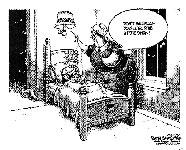
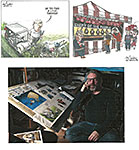
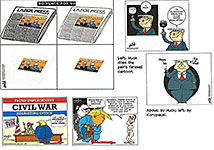
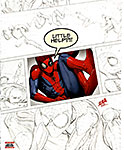


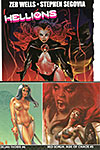

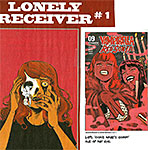
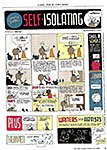

1.jpg)
2.jpg)
3.jpg)
1.jpg)
2.jpg)
3.jpg)
4.jpg)
5.jpg)
6.jpg)
7.jpg)
8.jpg)
9.jpg)
10.jpg)
11.jpg)
12.jpg)
13.jpg)
14.jpg)
15.jpg)
1.jpg)
2.jpg)
3.jpg)
4.jpg)
5.jpg)
6.jpg)
7.jpg)

